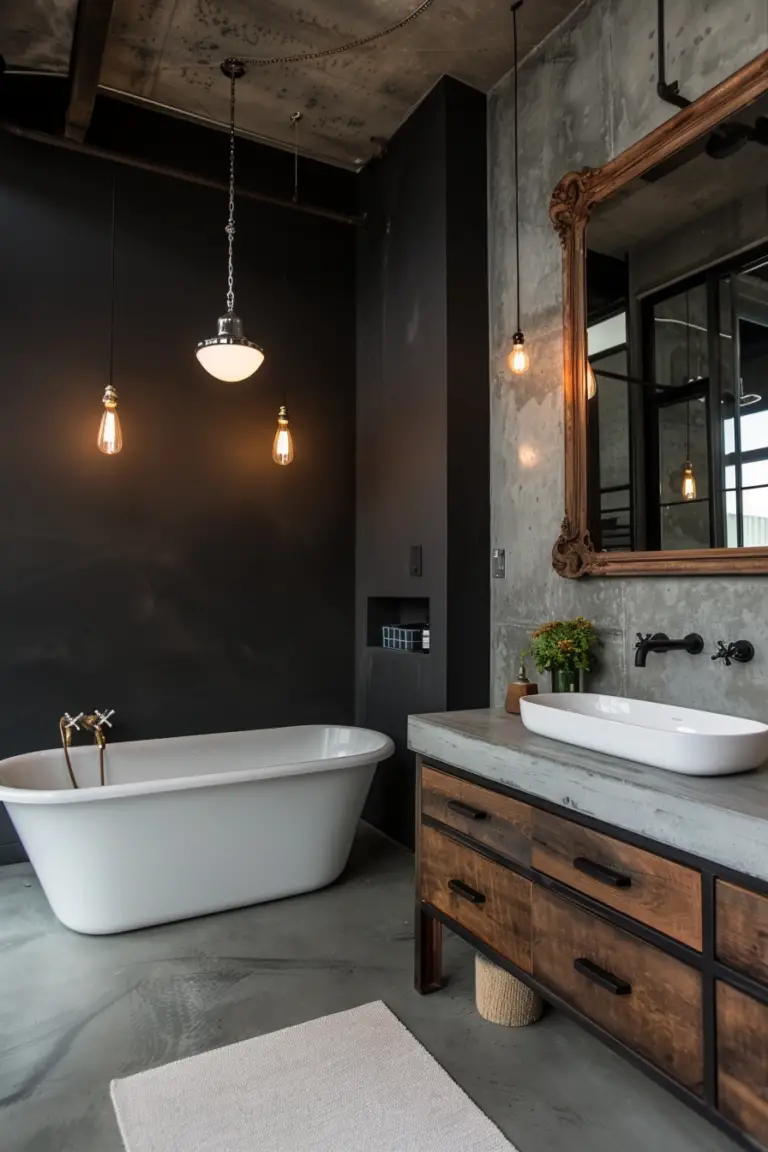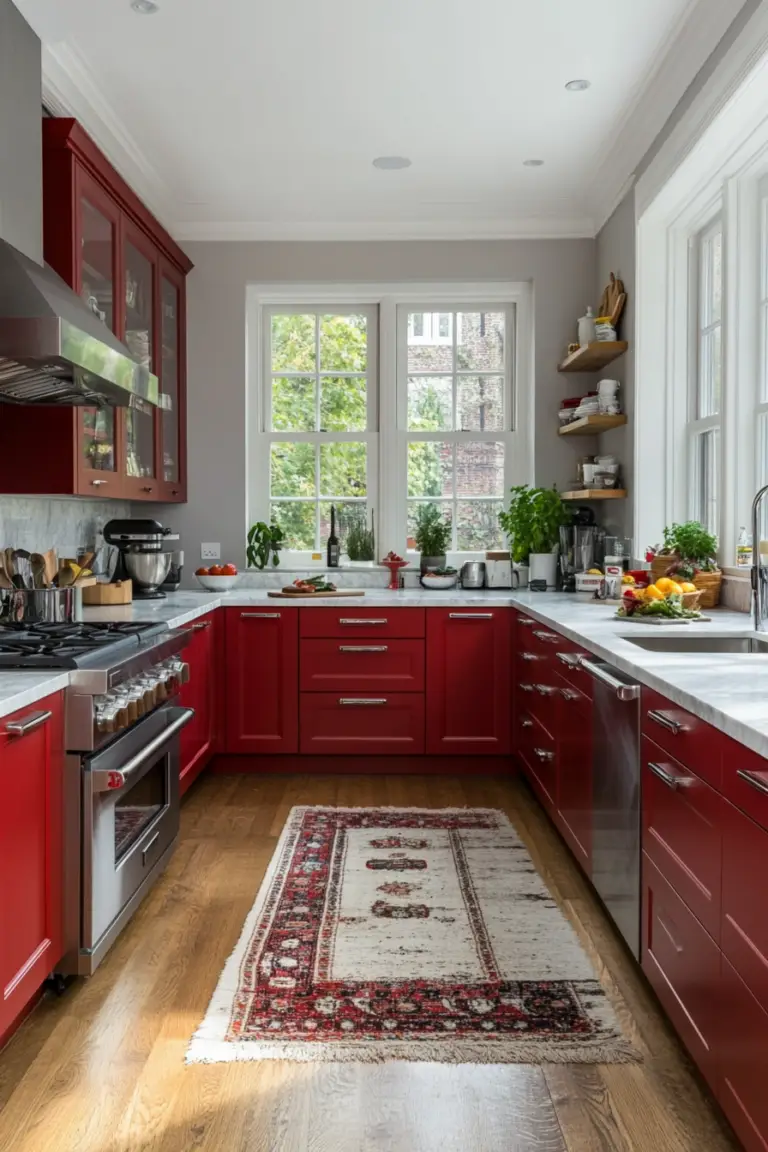15 Tips for Achieving a Minimalist Bedroom
Minimalism in the bedroom is about creating a serene and clutter-free environment that promotes relaxation and peace. Whether you have a small space, love color, or prefer a modern aesthetic, these tips will help you transform your bedroom into a minimalist haven.
1. Modern Minimalism
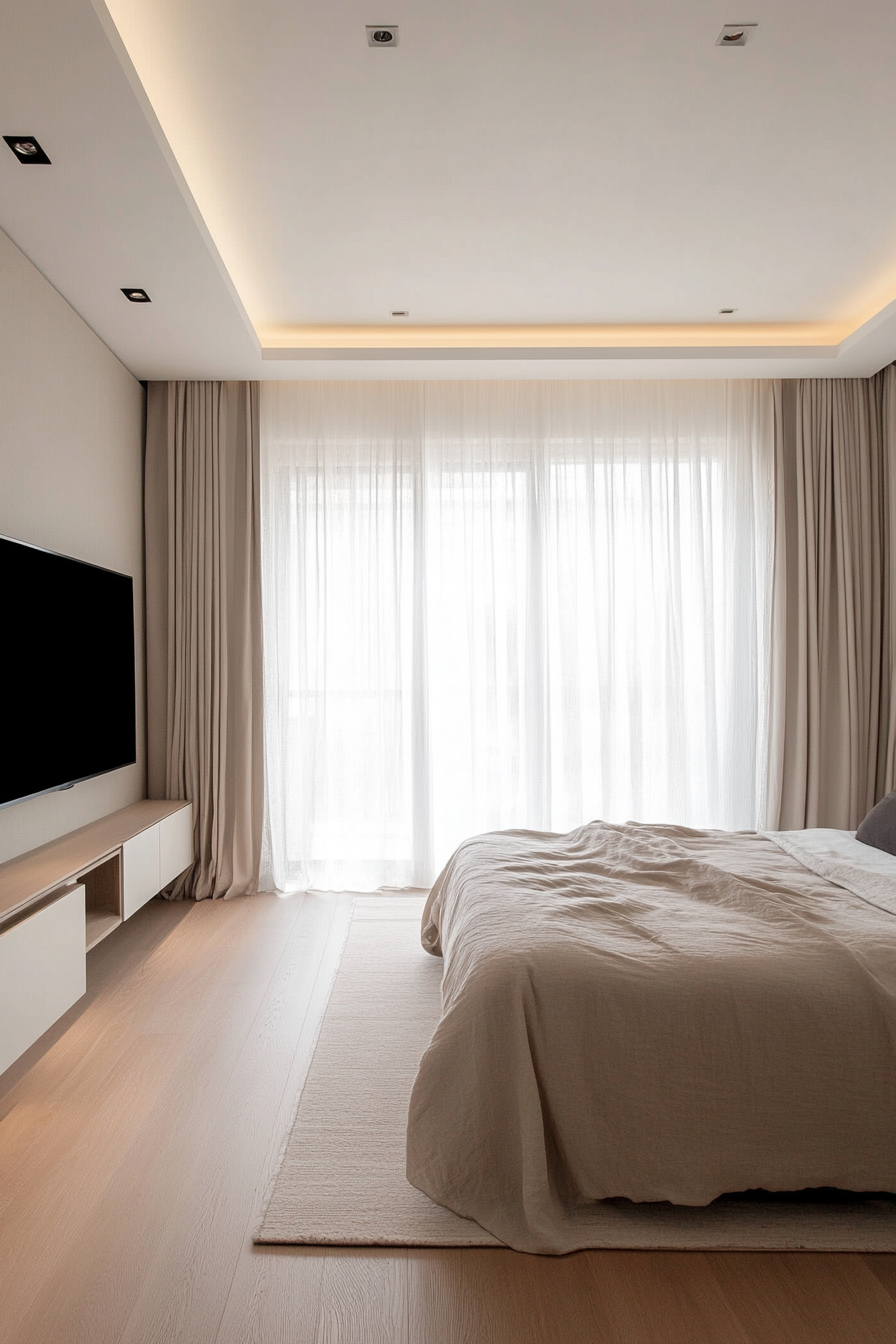
Modern minimalist bedrooms are defined by their simplicity and functionality. Start with a neutral color palette—think whites, greys, and blacks—to create a clean backdrop. Opt for sleek, low-profile furniture that emphasizes straight lines and smooth surfaces. Avoid ornate details and choose pieces with built-in storage to maintain a clutter-free environment.
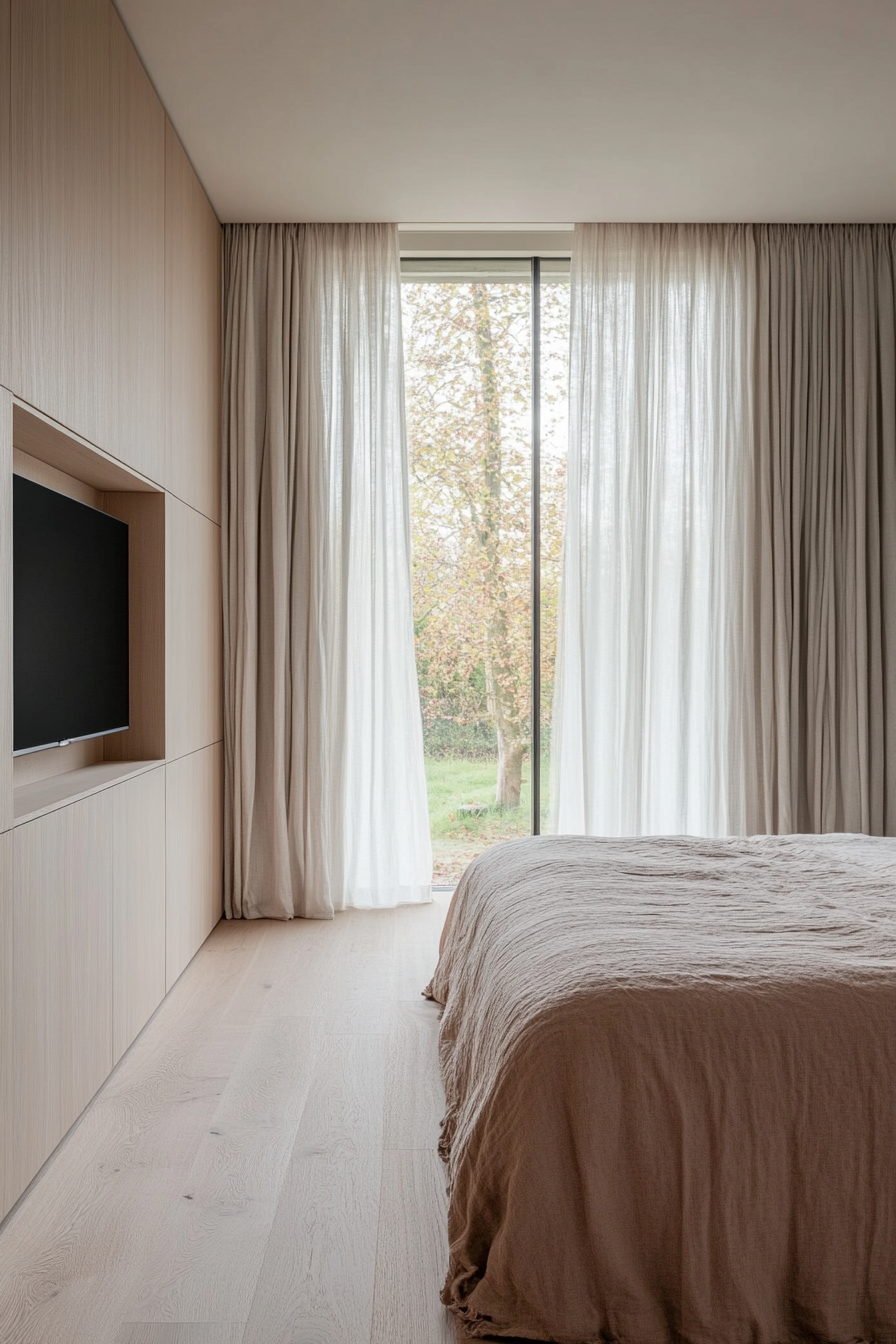
Incorporate technology thoughtfully. A wall-mounted television or smart lighting system can add convenience without disrupting the minimalist aesthetic. Use materials like metal, glass, and wood to add texture and interest while keeping the overall look streamlined and modern.
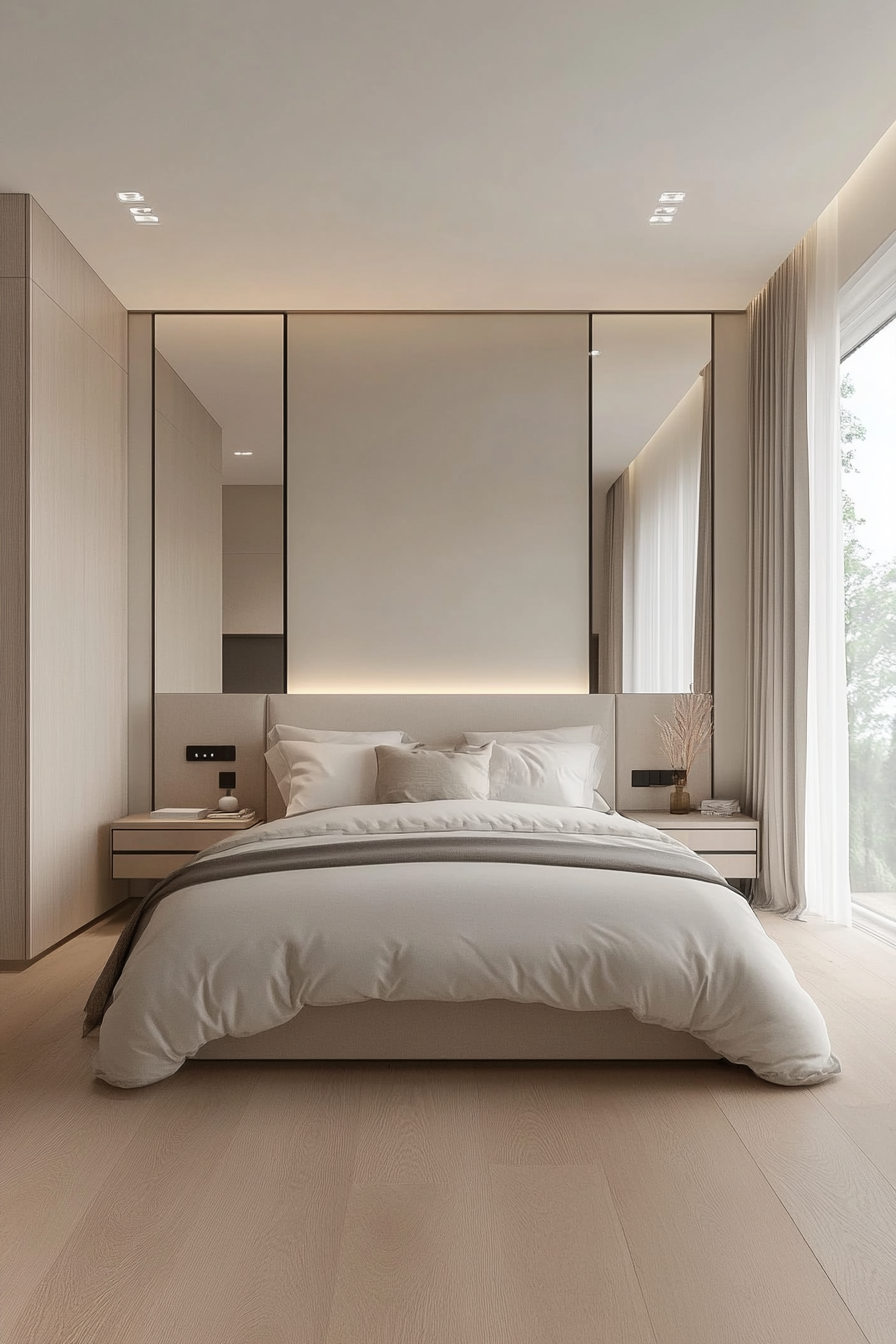
Decorate sparingly with abstract art, geometric patterns, and a few well-chosen accessories. Large windows or mirrors can enhance the sense of space, making the room feel larger and more open. The goal is to create a calm and uncluttered sanctuary where every item has a purpose.
2. Small Space Solutions
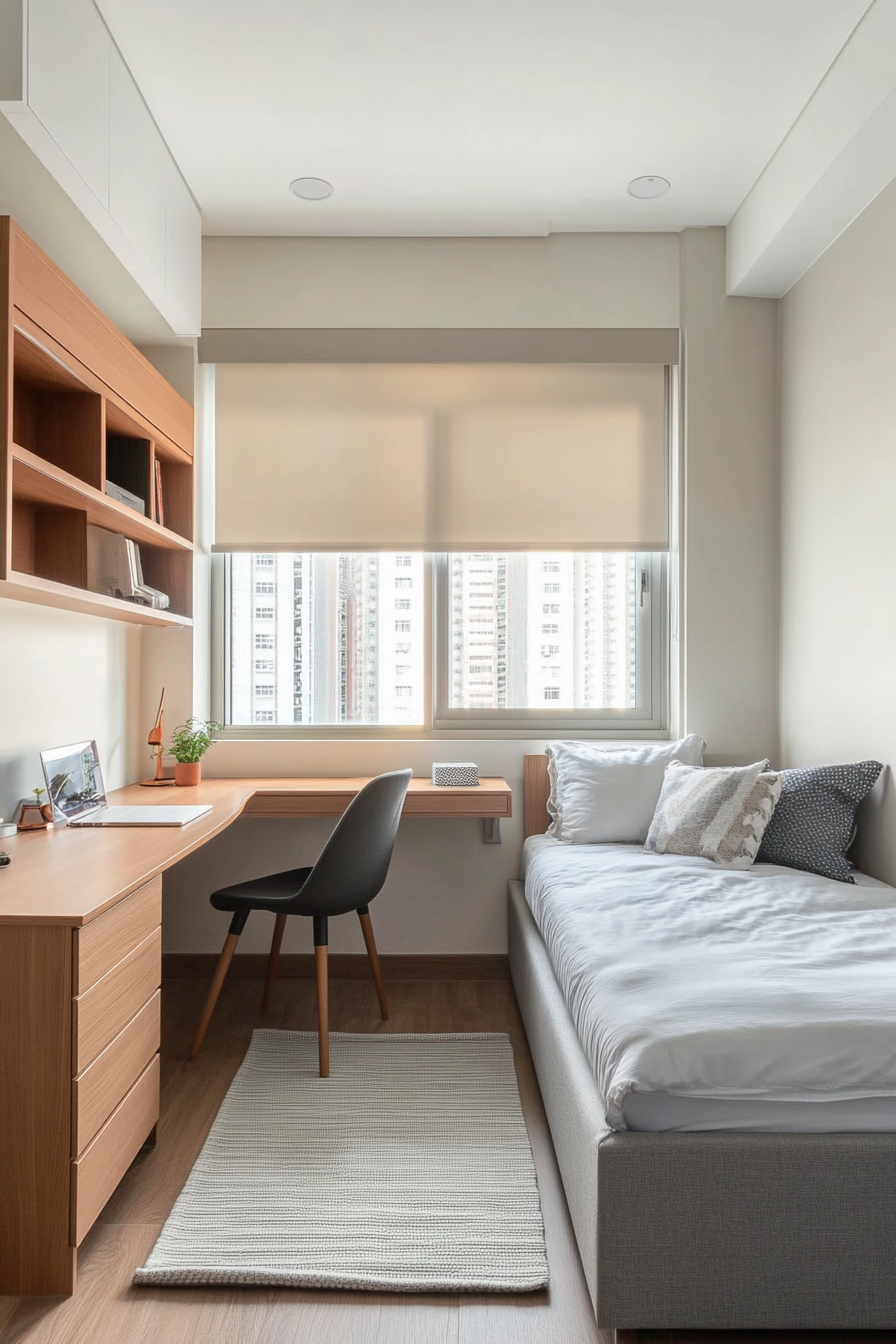
In a small bedroom, every inch counts. Maximize your space by choosing multifunctional furniture like a bed with drawers underneath or a desk that doubles as a nightstand. Vertical storage solutions such as wall-mounted shelves can help keep surfaces clear and maintain an open feel.
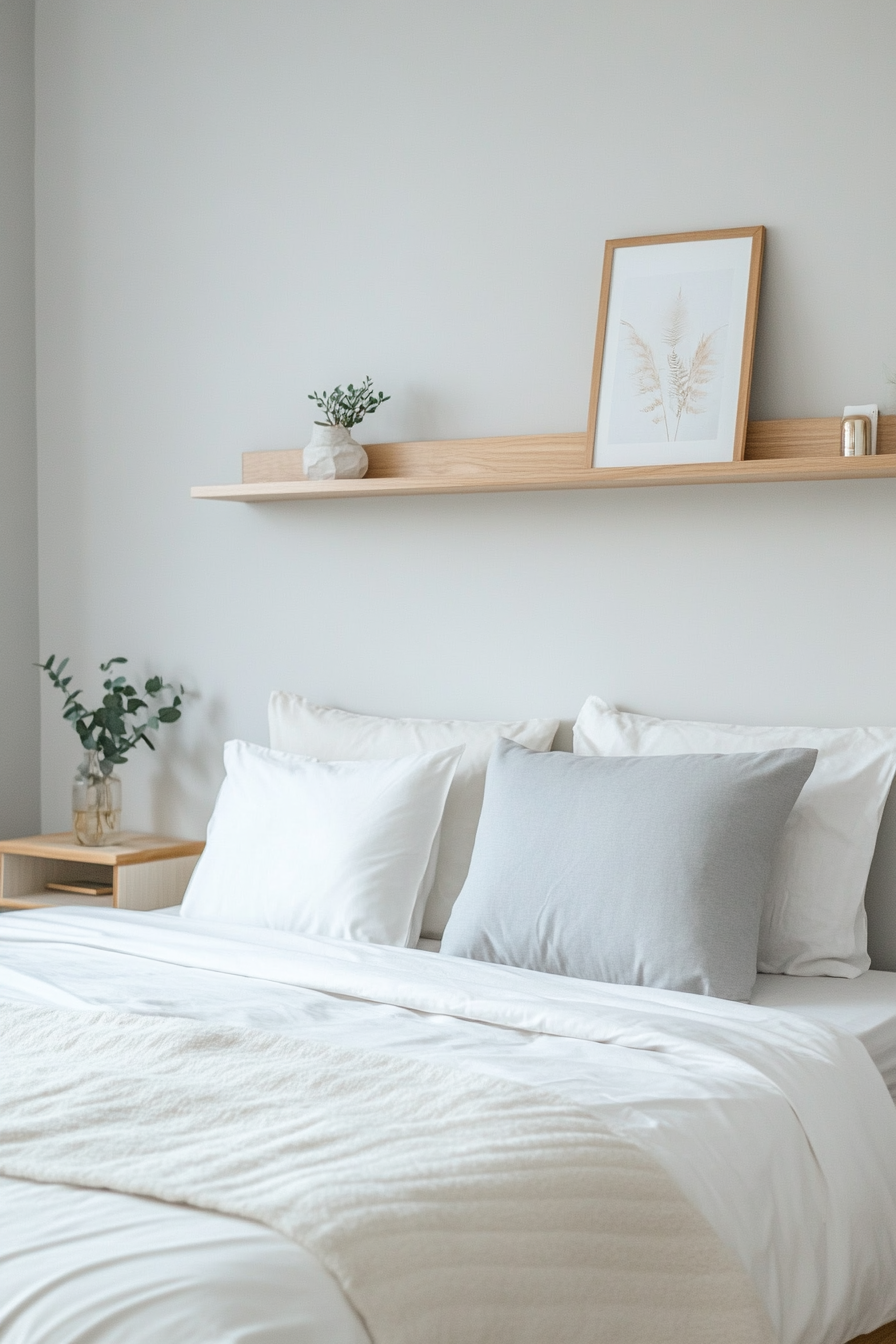
Keep the color scheme light and airy to make the room feel larger. Soft pastels, whites, and light greys work well. Reflective surfaces like mirrors or glossy finishes can also help bounce light around the room, enhancing the sense of space.
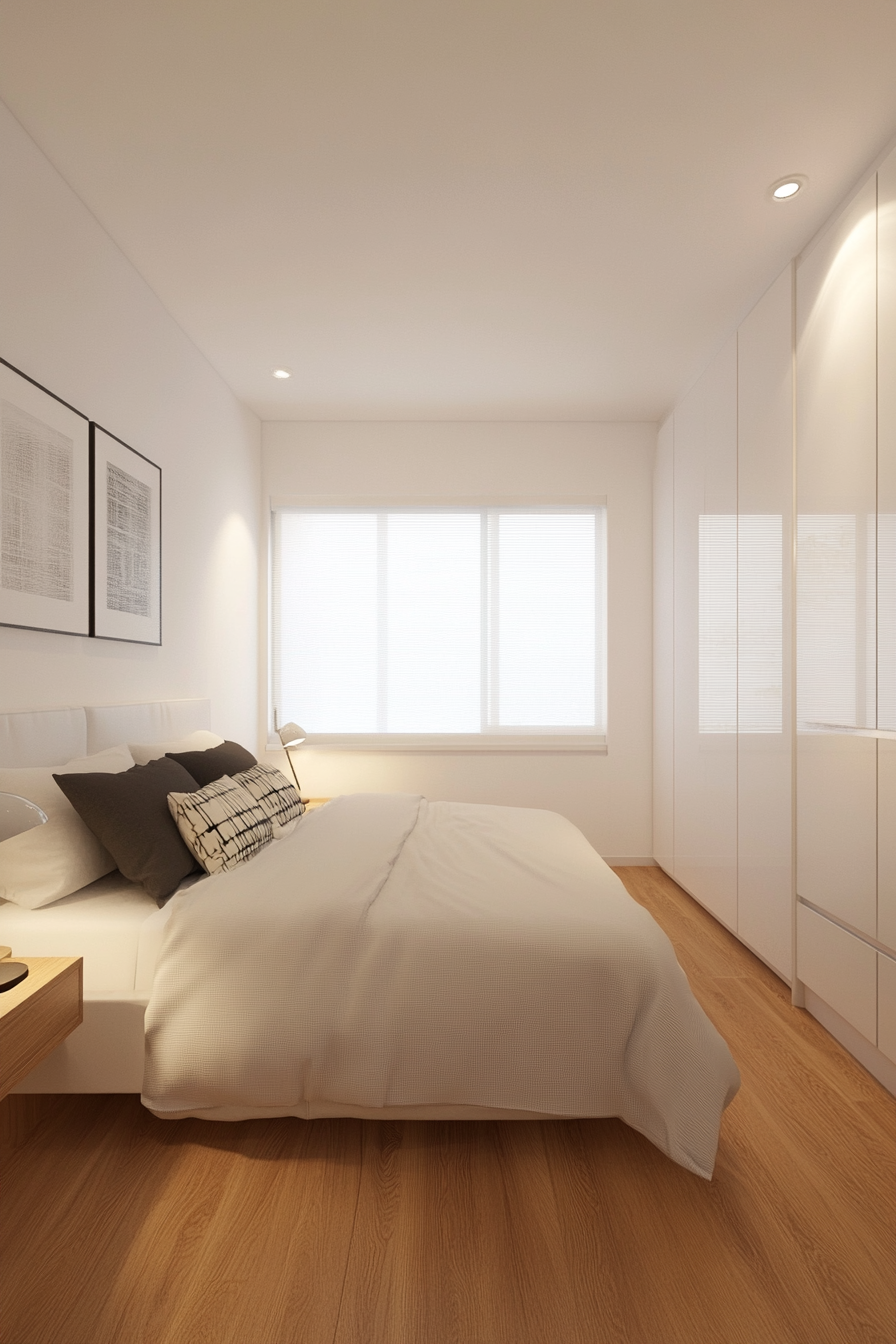
Limit decorations to a few key pieces. A small potted plant, a framed photo, or a piece of art can add personality without overwhelming the space. The key is to strike a balance between functionality and aesthetics, ensuring the room remains a peaceful retreat.
3. Adding Color to Minimalism
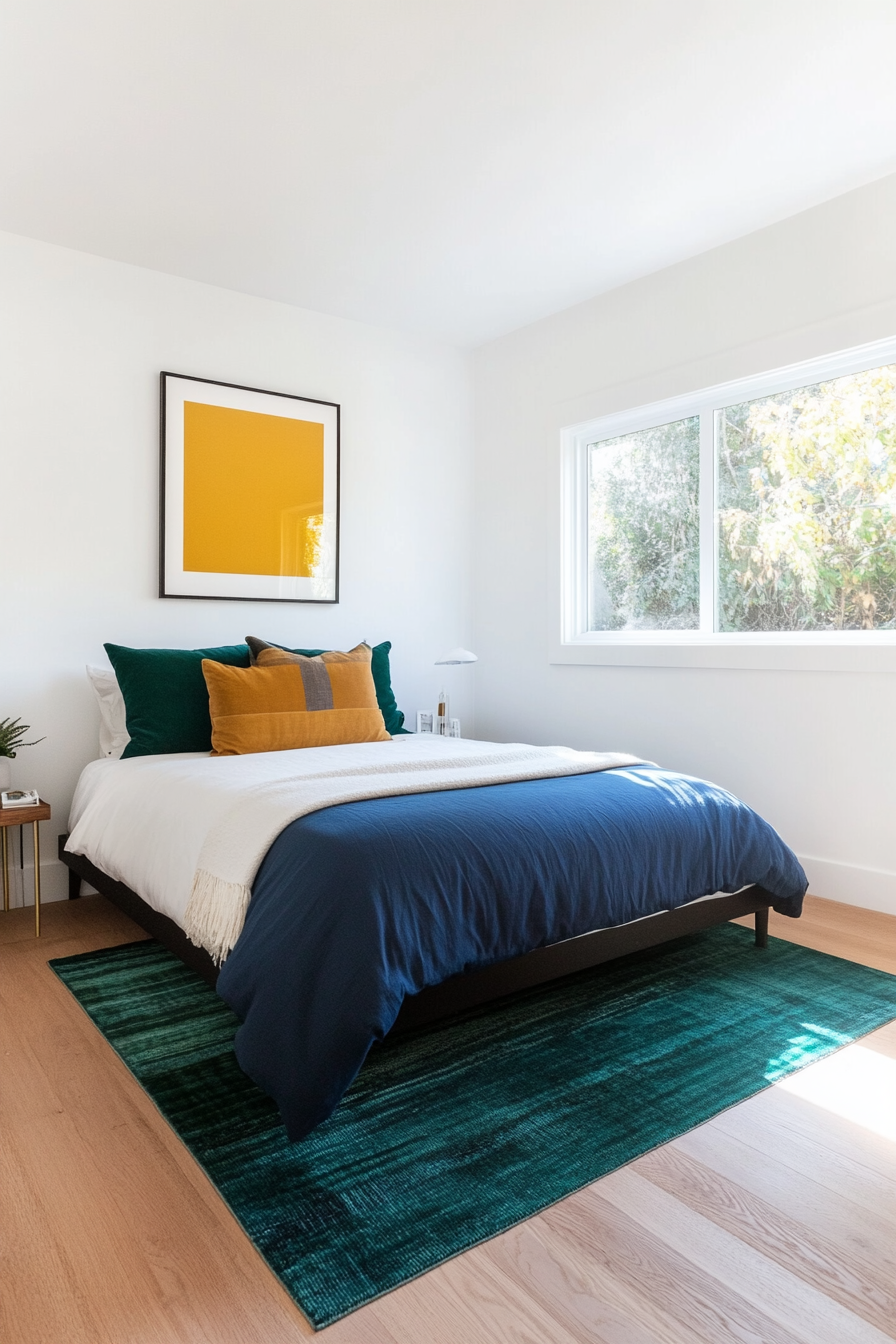
Minimalist doesn’t have to mean boring. Introduce color in a controlled manner to maintain the minimalist vibe. Choose a base of neutral tones and add pops of color through bedding, rugs, or artwork. Bold colors like deep blue, emerald green, or mustard yellow can make a striking impact without overwhelming the space.
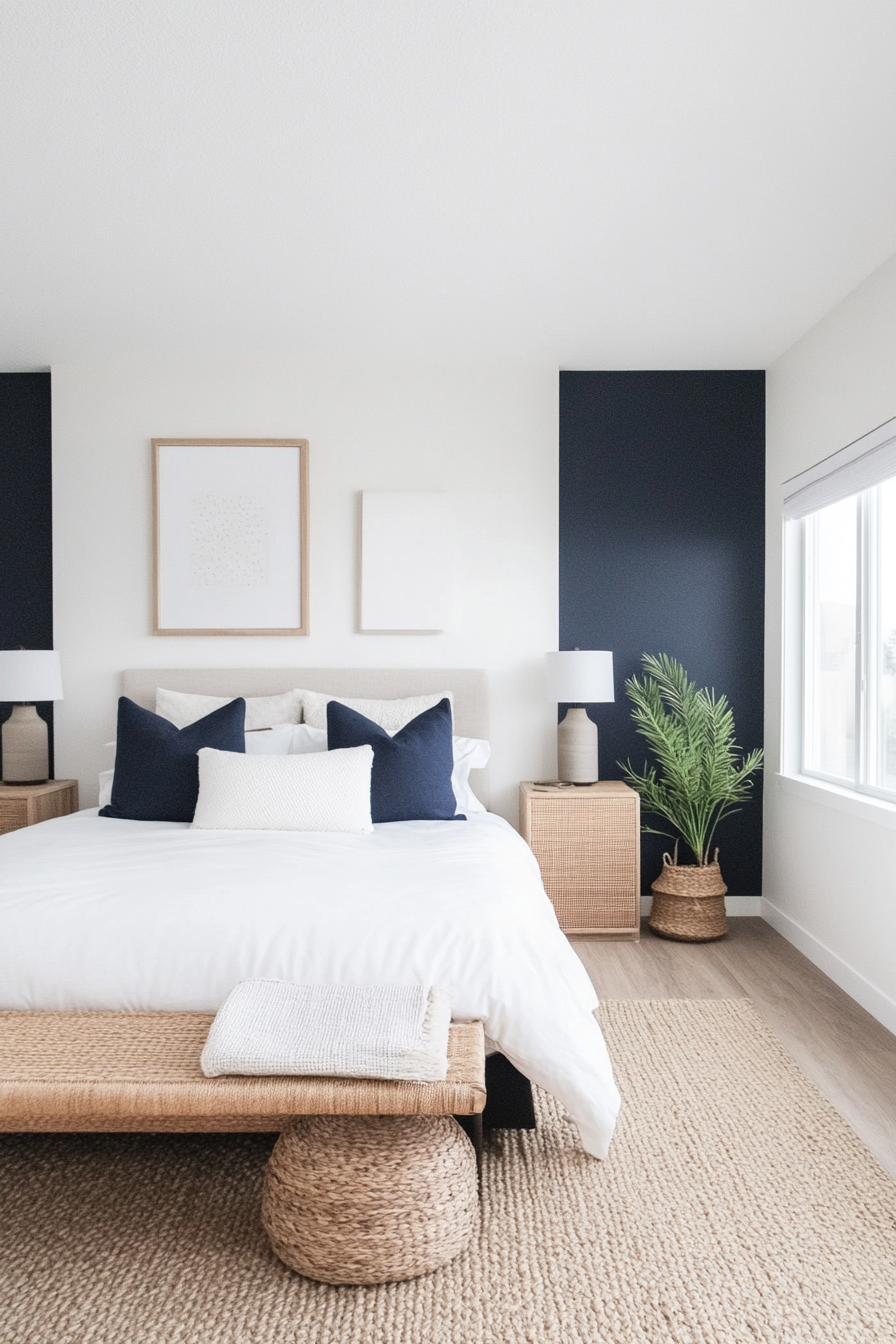
Stick to one or two accent colors to keep the look cohesive. For example, a white bedroom with navy blue accents in the form of pillows, throws, or an accent wall can look sophisticated yet minimal. Natural materials like wood or rattan can also add warmth and texture.
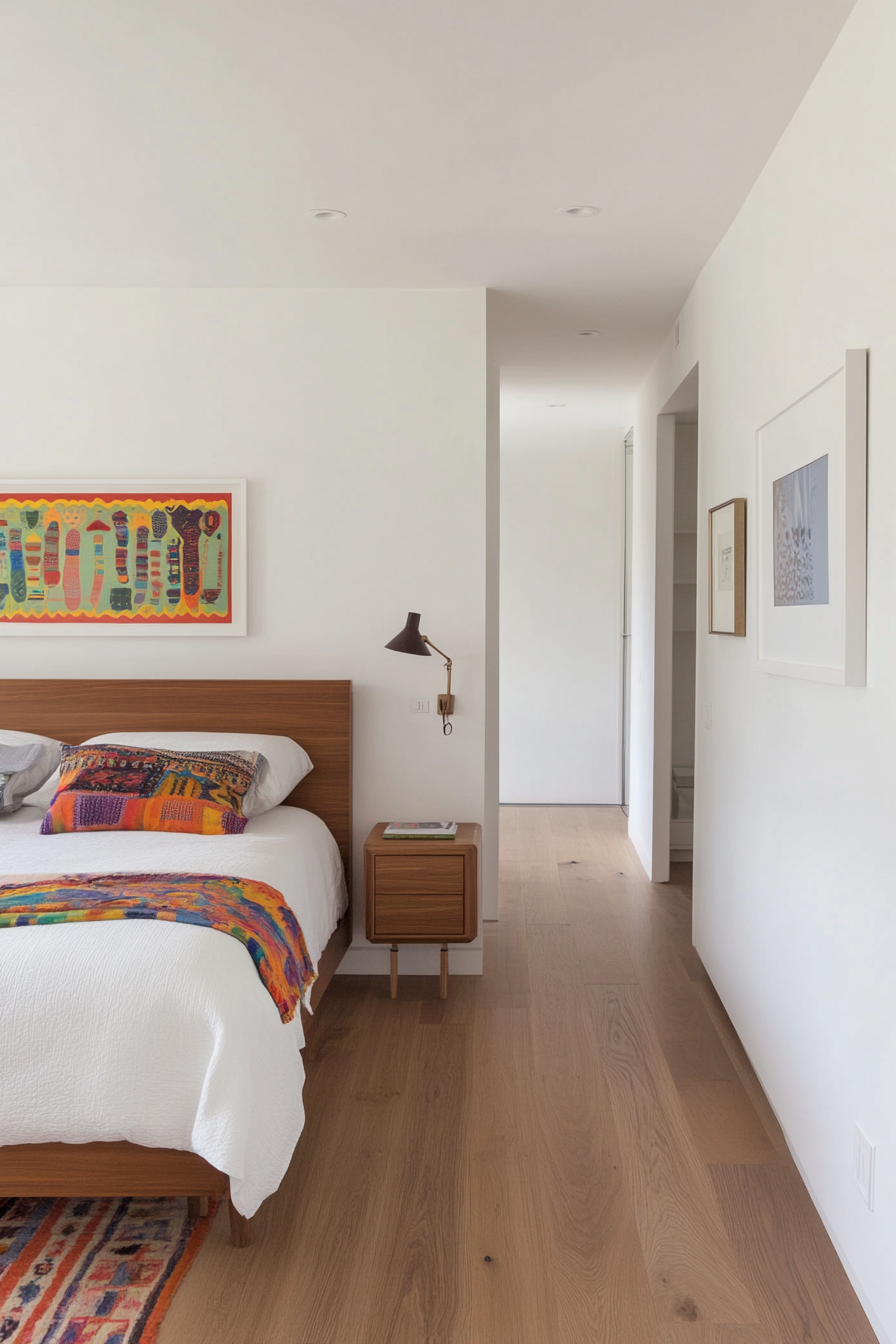
Use color to highlight architectural features or create focal points. A colorful headboard or a vibrant piece of art can draw the eye and add interest without cluttering the room. The key is to use color sparingly and thoughtfully.
4. Design Explanation
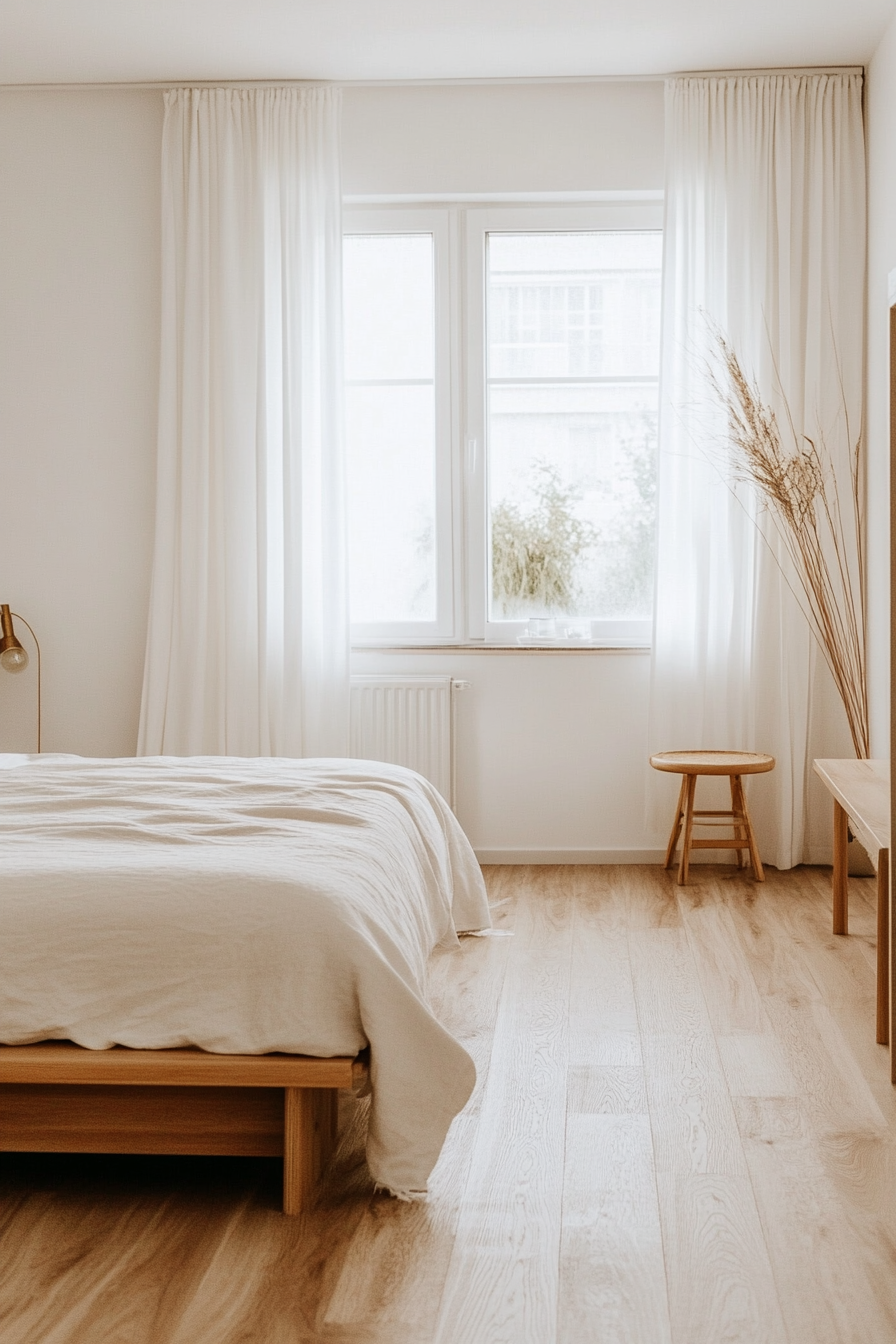
Minimalist design is rooted in the philosophy of “less is more.” It focuses on simplicity, functionality, and the elimination of excess. The goal is to create a space that is serene, orderly, and visually calm. This is achieved through the careful selection of furniture, decor, and color palettes that contribute to a harmonious and clutter-free environment.
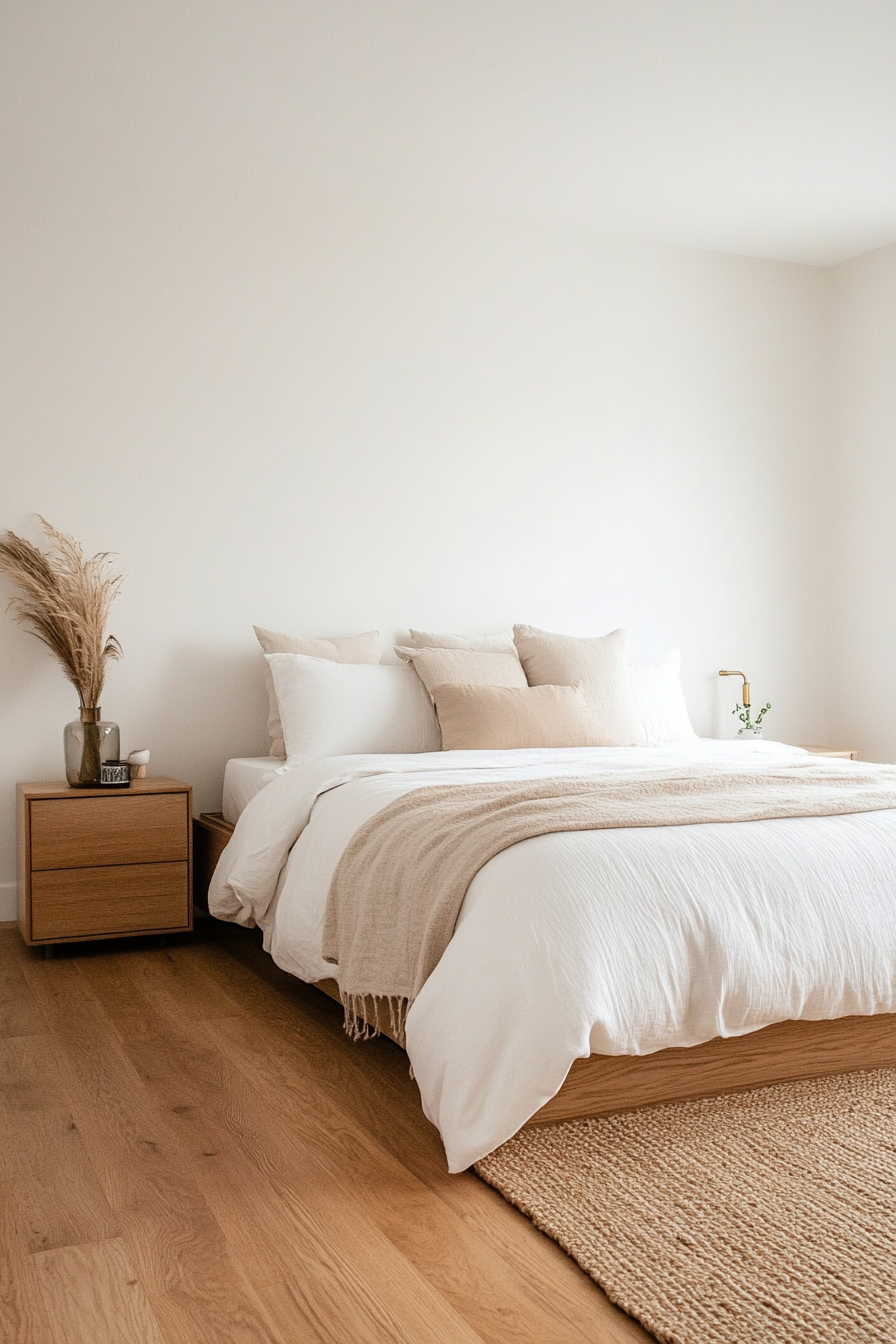
Furniture in a minimalist bedroom is often sleek and functional, with clean lines and a lack of ornamentation. Storage solutions are integrated to keep surfaces clear and maintain a sense of order. The color palette is typically neutral, creating a calm and serene backdrop.
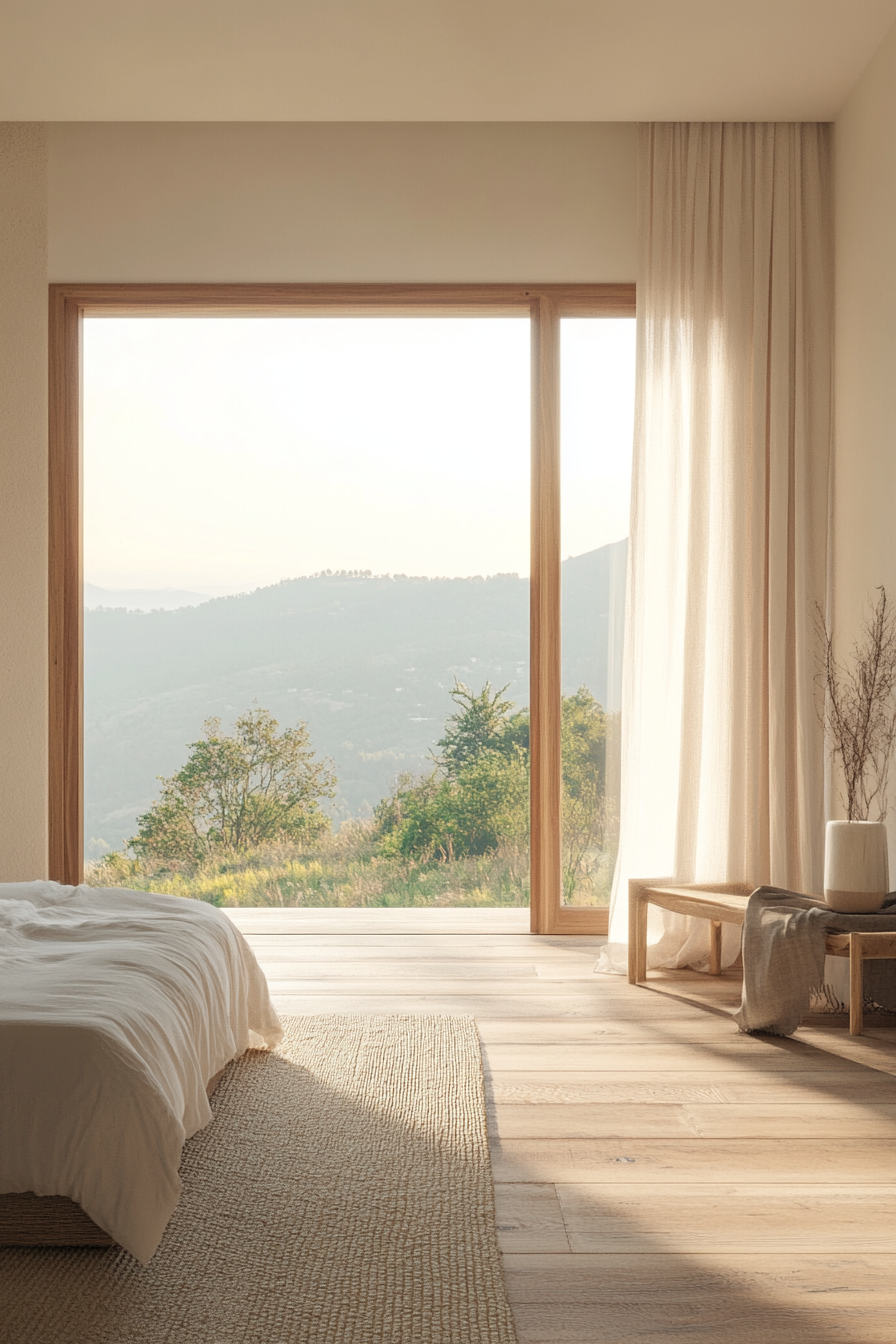
Decor is kept to a minimum, with a few well-chosen pieces that add personality and interest without overwhelming the space. The emphasis is on quality over quantity, with each item serving a specific purpose. This approach creates a bedroom that is both beautiful and functional.
5. Minimalist Decor
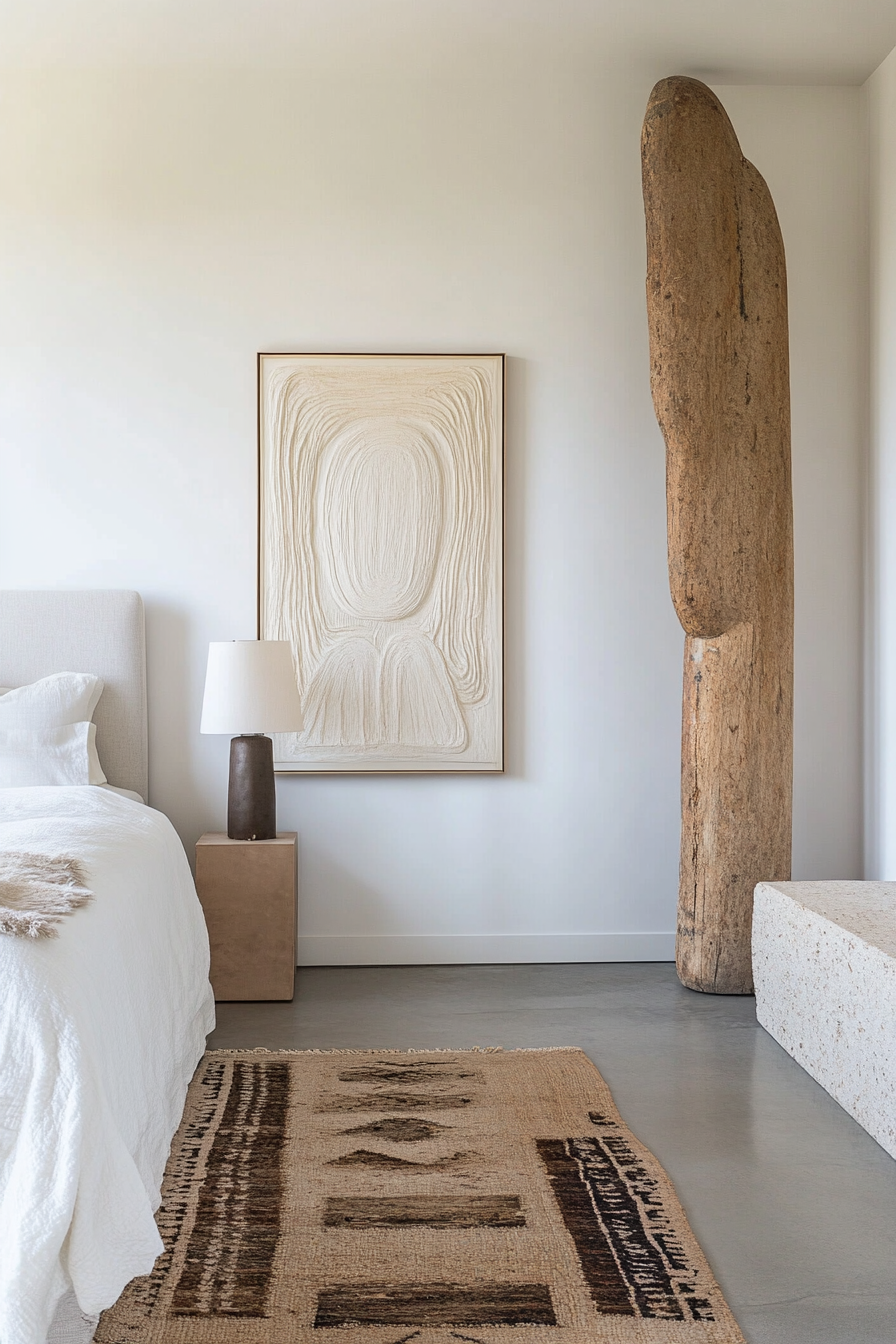
When it comes to minimalist decor, less is definitely more. Choose a few statement pieces rather than filling the room with knick-knacks. A large piece of art, a sculptural lamp, or a beautiful rug can add personality without creating clutter. The key is to select items that you love and that contribute to the overall aesthetic.

Natural materials like wood, stone, and linen can add texture and warmth to a minimalist bedroom. Opt for furniture and decor with clean lines and simple shapes. Avoid overly ornate or fussy designs, which can detract from the minimalist vibe.
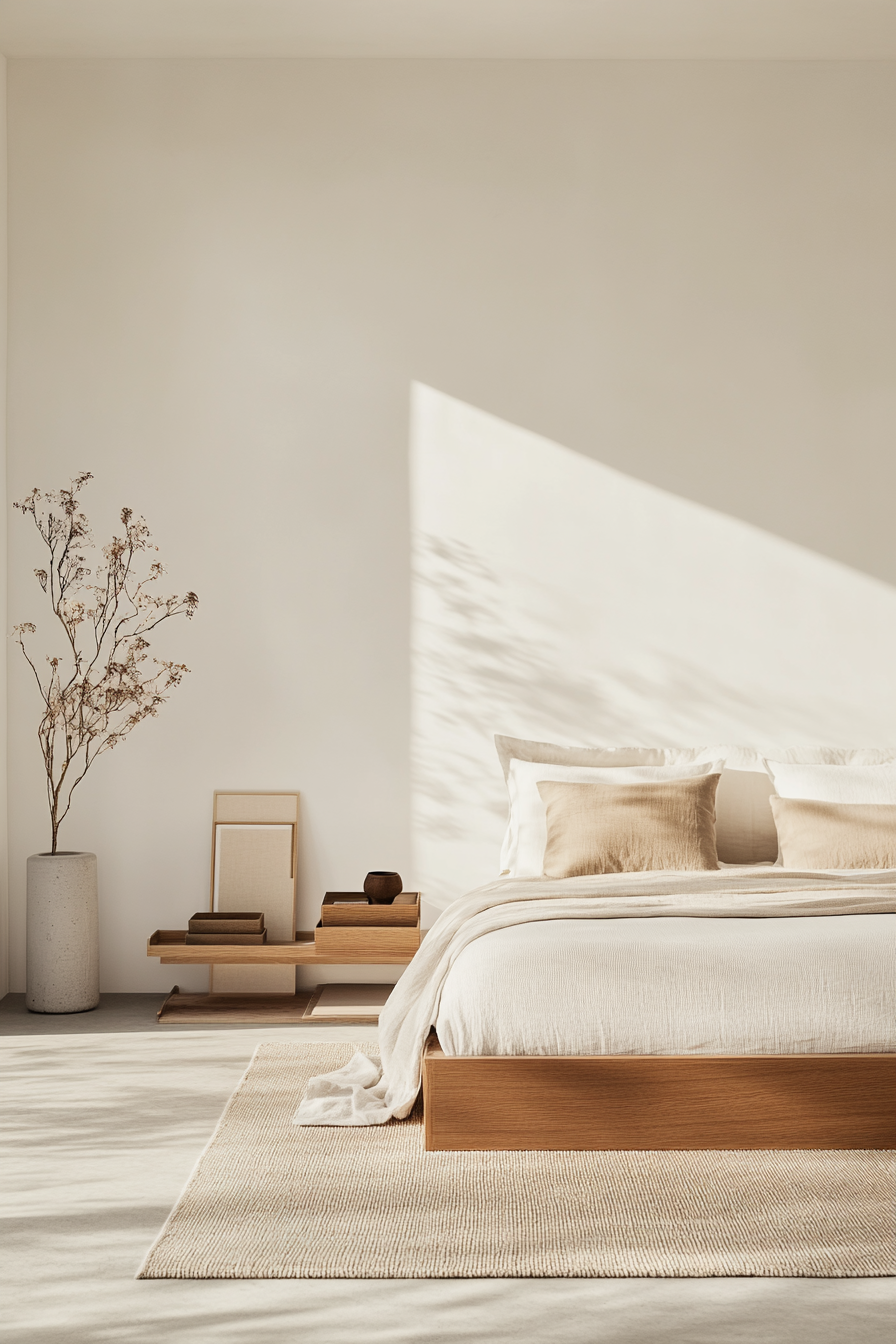
Keep surfaces clear and organized. Use trays or boxes to corral small items and maintain a sense of order. The goal is to create a space that feels serene and uncluttered, where each item has a purpose and a place.
6. Loft Beds
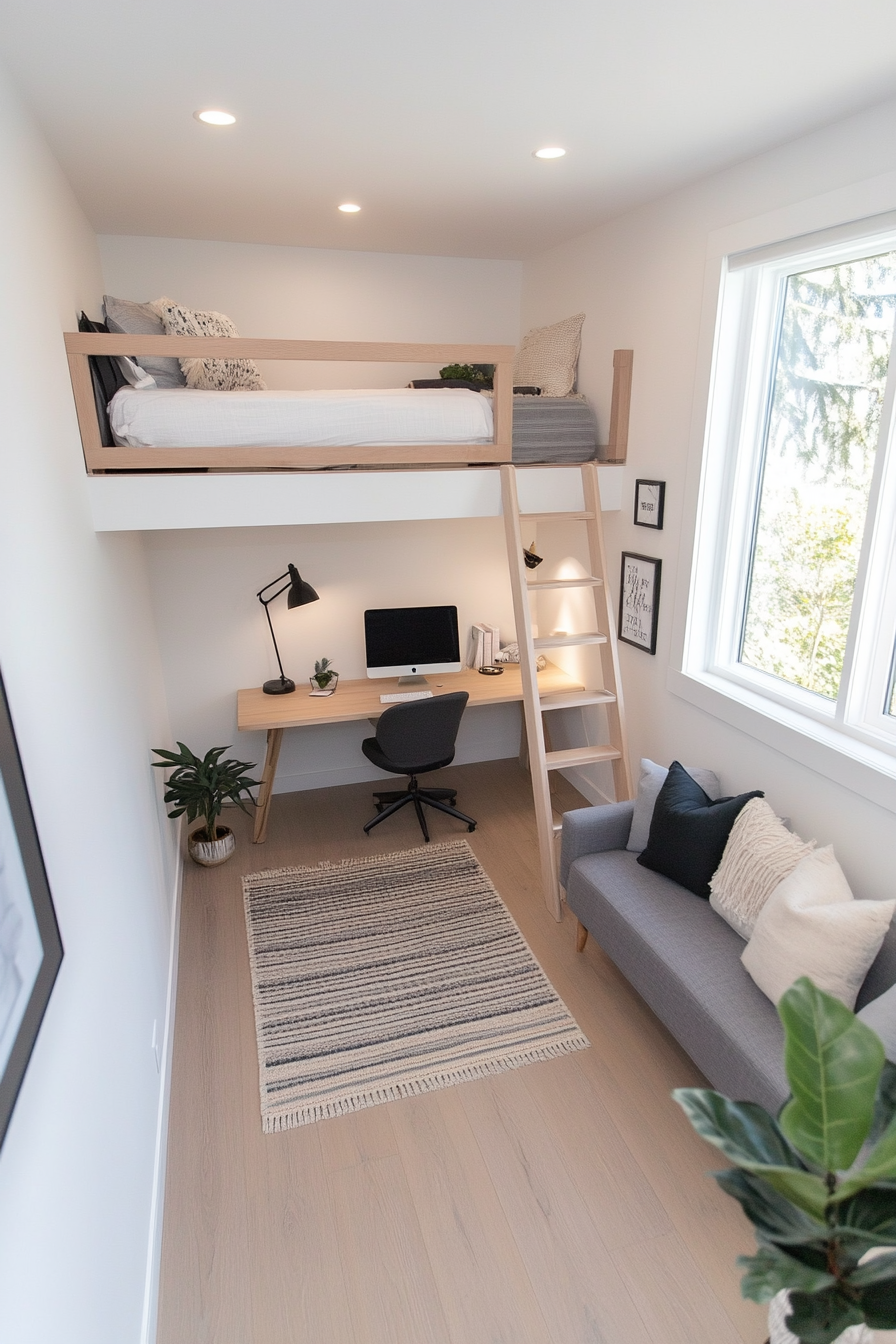
Loft beds are a fantastic solution for small bedrooms or for those who want to maximize space. By raising the bed off the ground, you create additional floor space that can be used for a desk, seating area, or storage. This is particularly useful in studio apartments or children’s rooms.
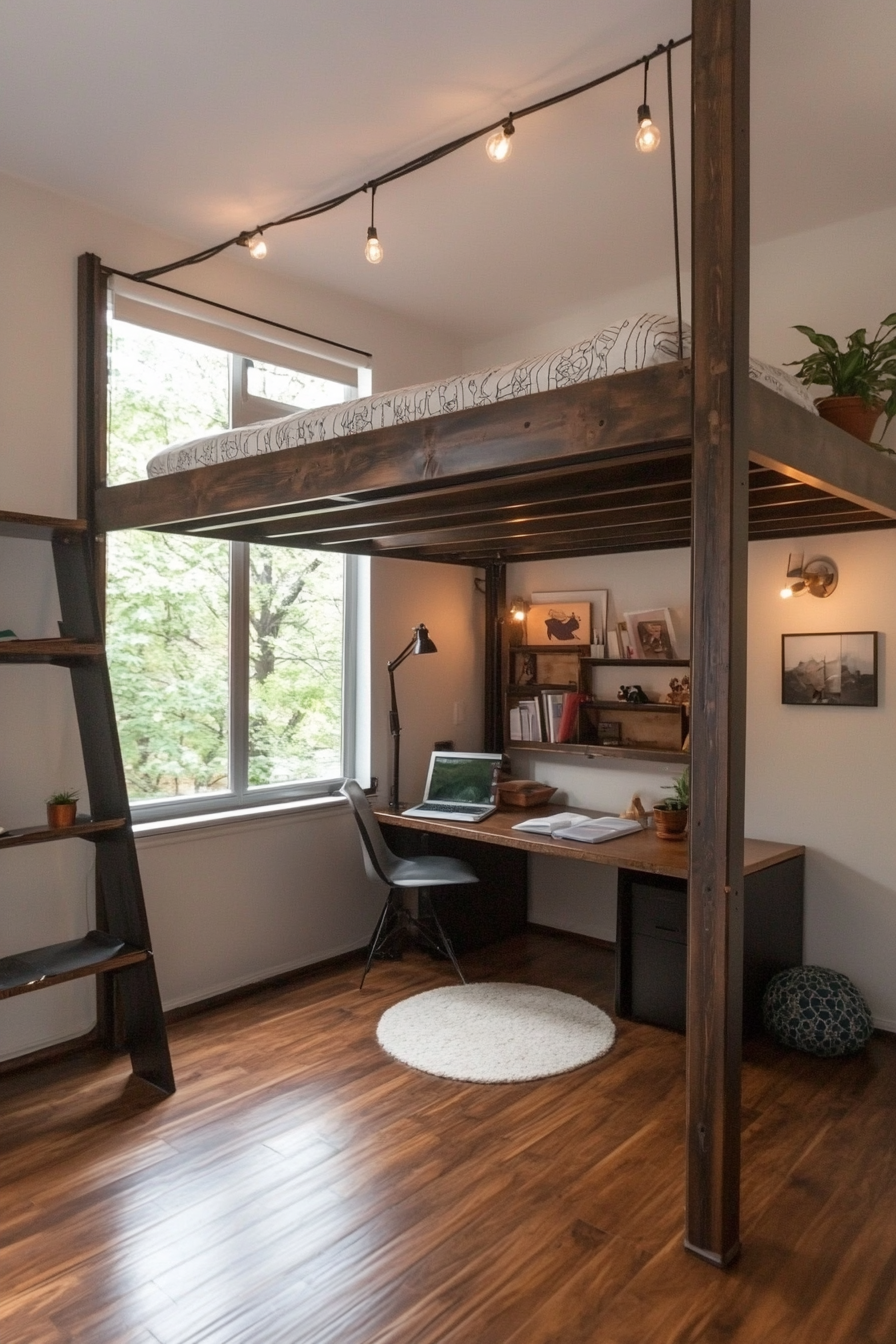
Choose a loft bed with a sleek and simple design to maintain the minimalist aesthetic. Metal or wood frames with clean lines work well. Make sure the area underneath the bed is well-organized and not cluttered to keep the space feeling open and airy.
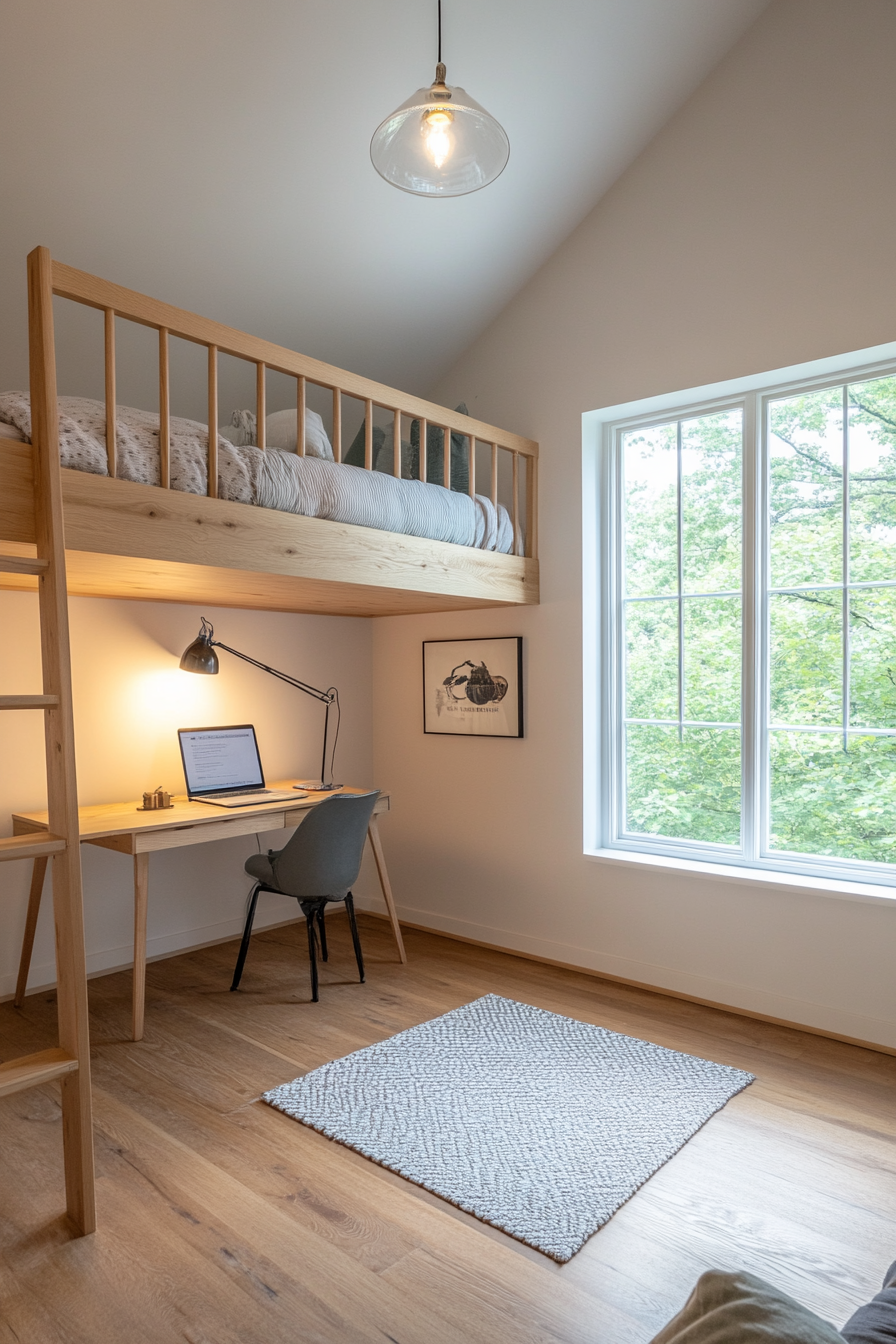
Incorporate lighting under the loft bed to create a cozy and functional space. A small desk lamp or string lights can add warmth and make the area more inviting. Keep decor to a minimum, focusing on functionality and simplicity.
7. Clean and Simple
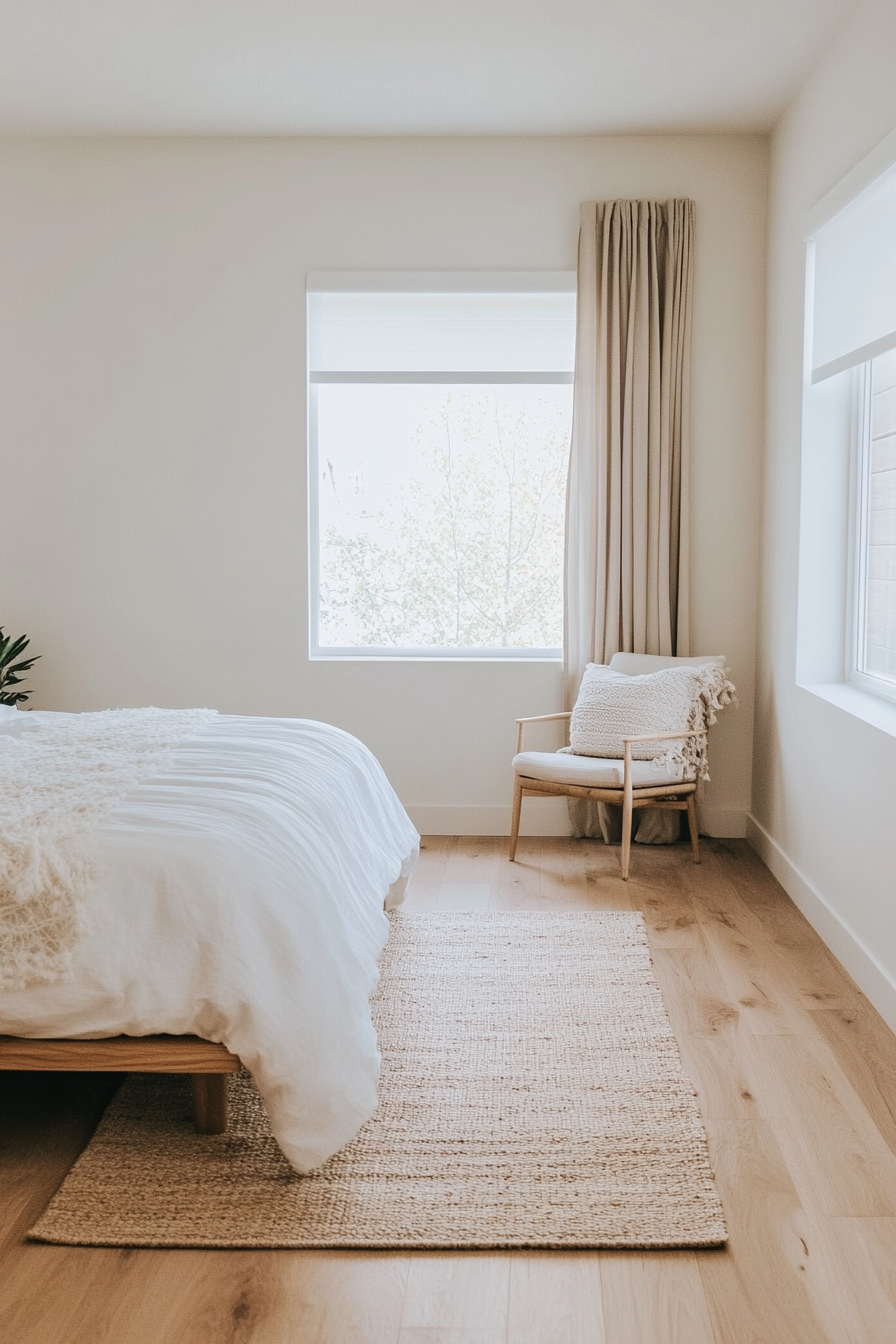
A clean and simple minimalist bedroom is all about creating a sense of calm and order. Start with a neutral color palette—whites, greys, and soft pastels work well. Choose furniture with clean lines and avoid unnecessary embellishments. The goal is to create a serene and uncluttered environment.
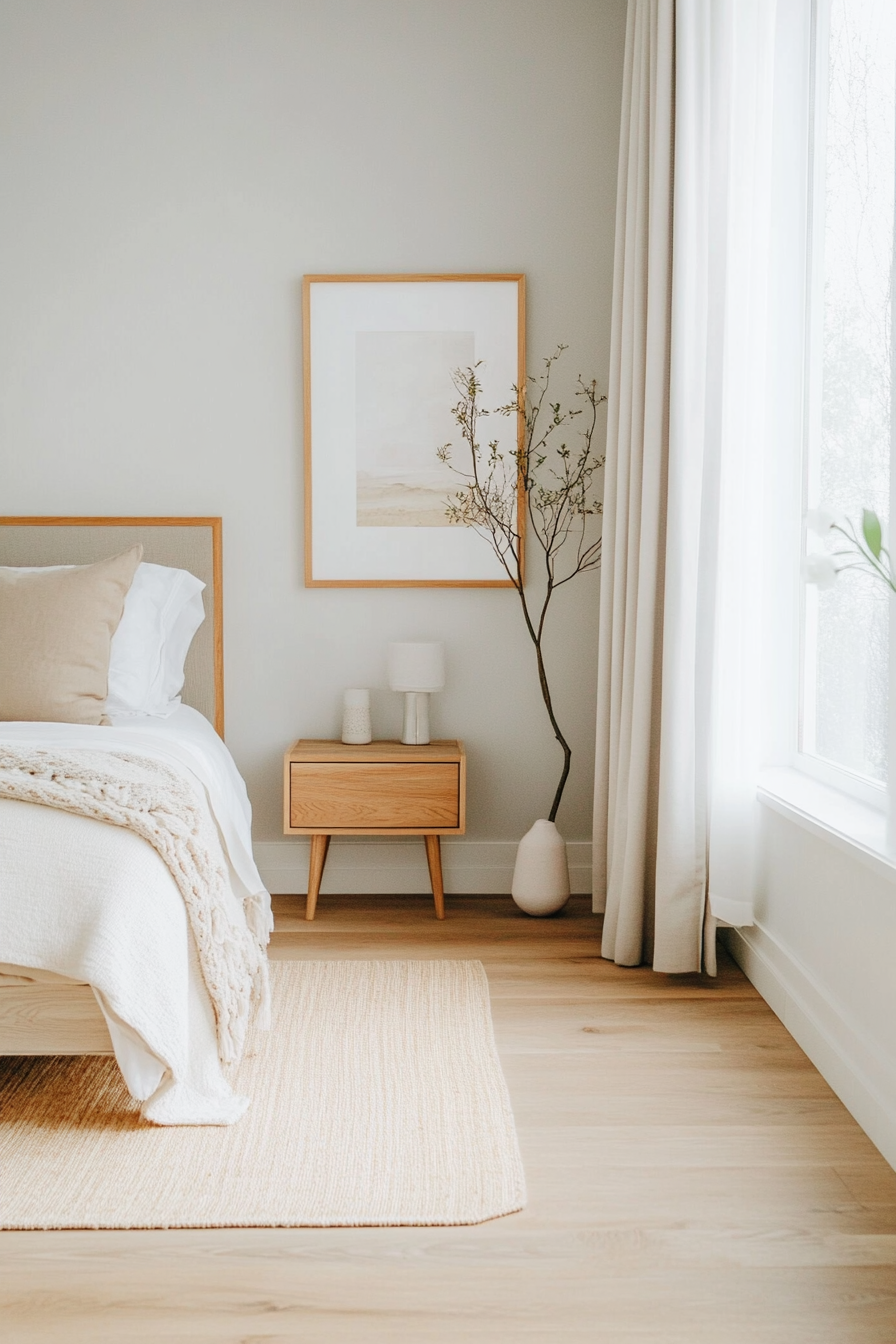
Keep decor to a minimum. A few well-chosen pieces, such as a large piece of art or a statement lamp, can add personality without overwhelming the space. Use storage solutions like built-in closets or under-bed drawers to keep clutter out of sight.
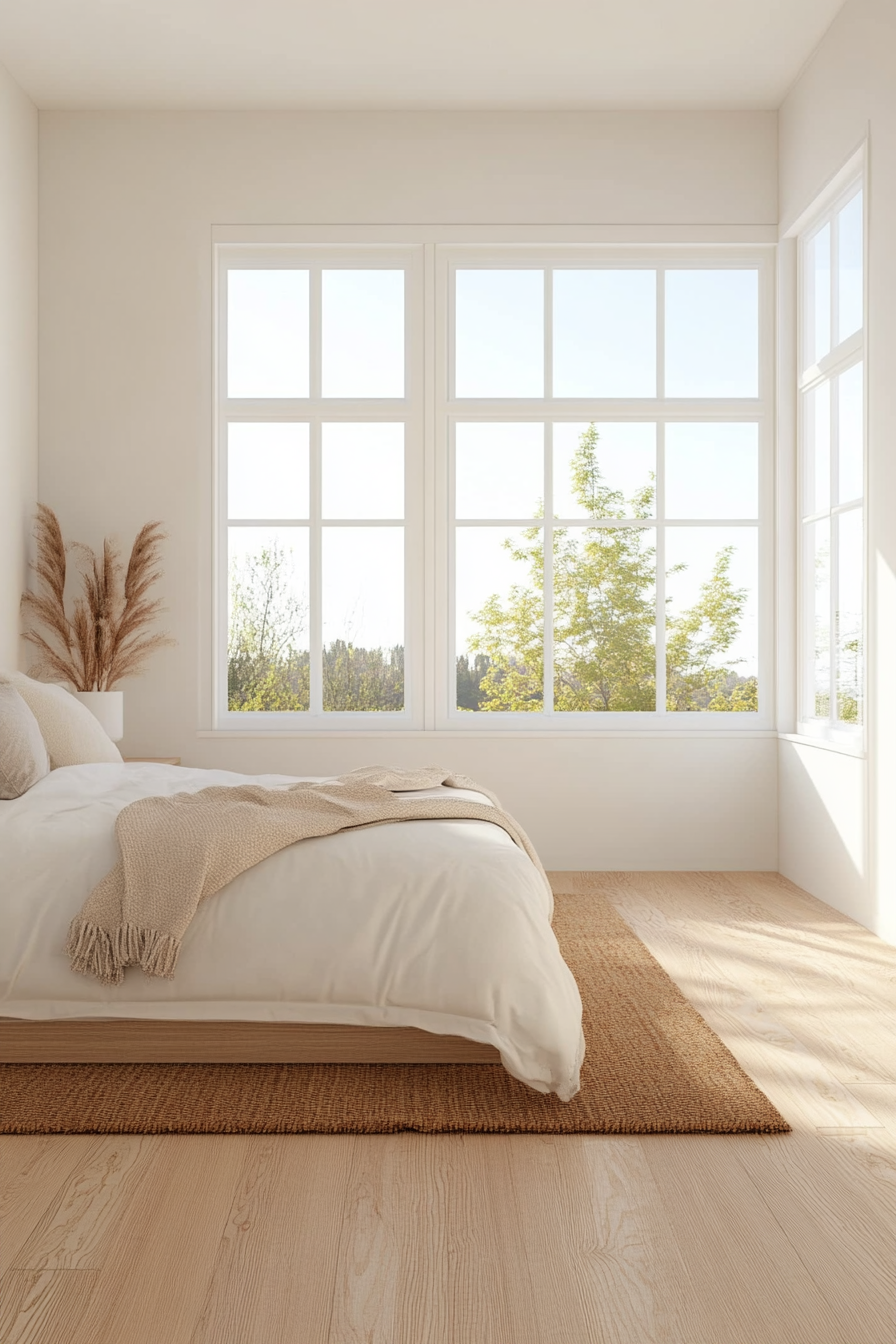
Focus on quality over quantity. Choose high-quality bedding, furniture, and decor that you love and that will stand the test of time. The result is a bedroom that feels peaceful, inviting, and timeless.
8. Dark Minimalism
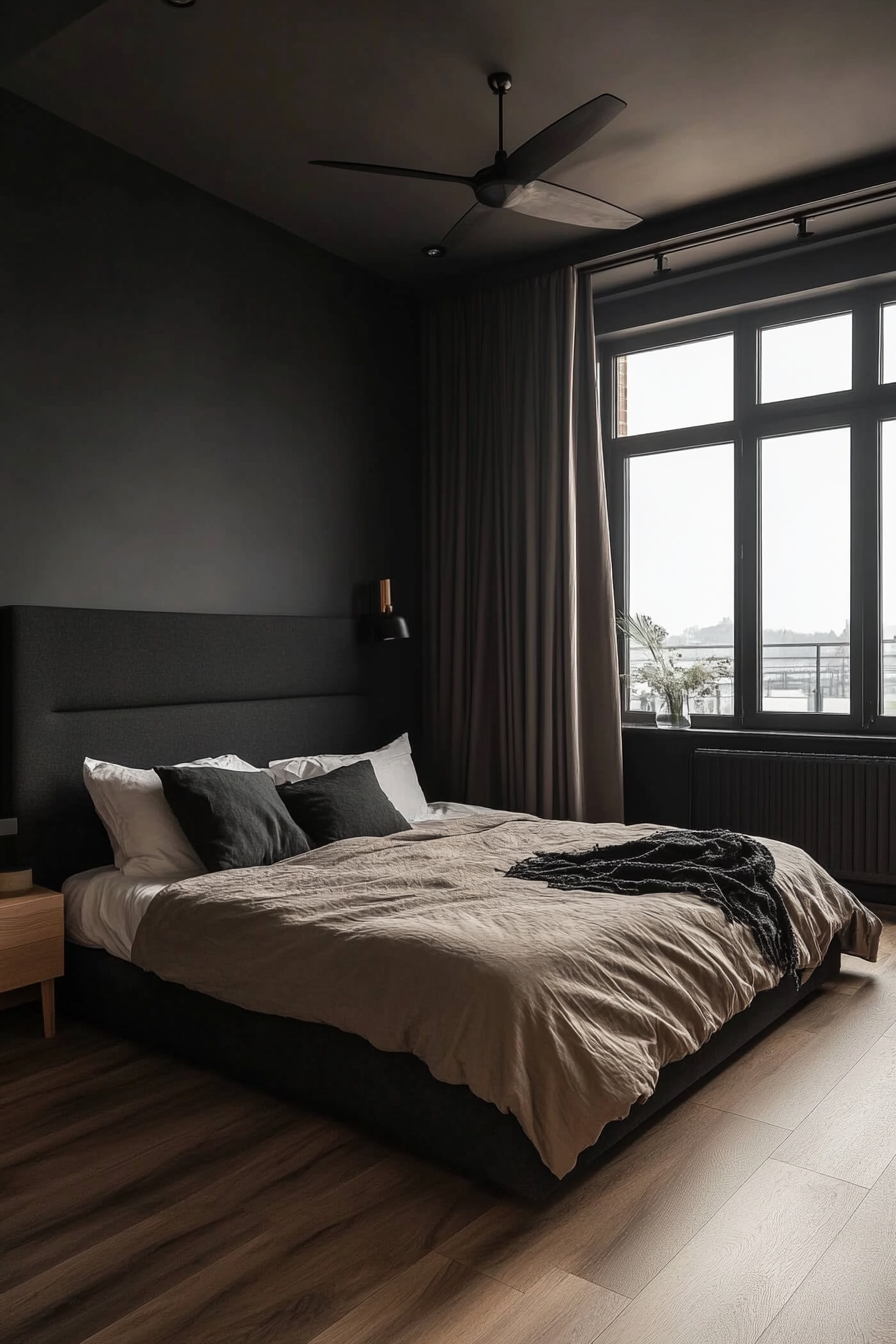
Dark minimalism can create a dramatic and cozy atmosphere in the bedroom. Start with a base of dark colors like black, charcoal, or deep navy. These shades can make the space feel intimate and cocoon-like. Use contrasting textures like velvet, leather, and metal to add depth and interest.
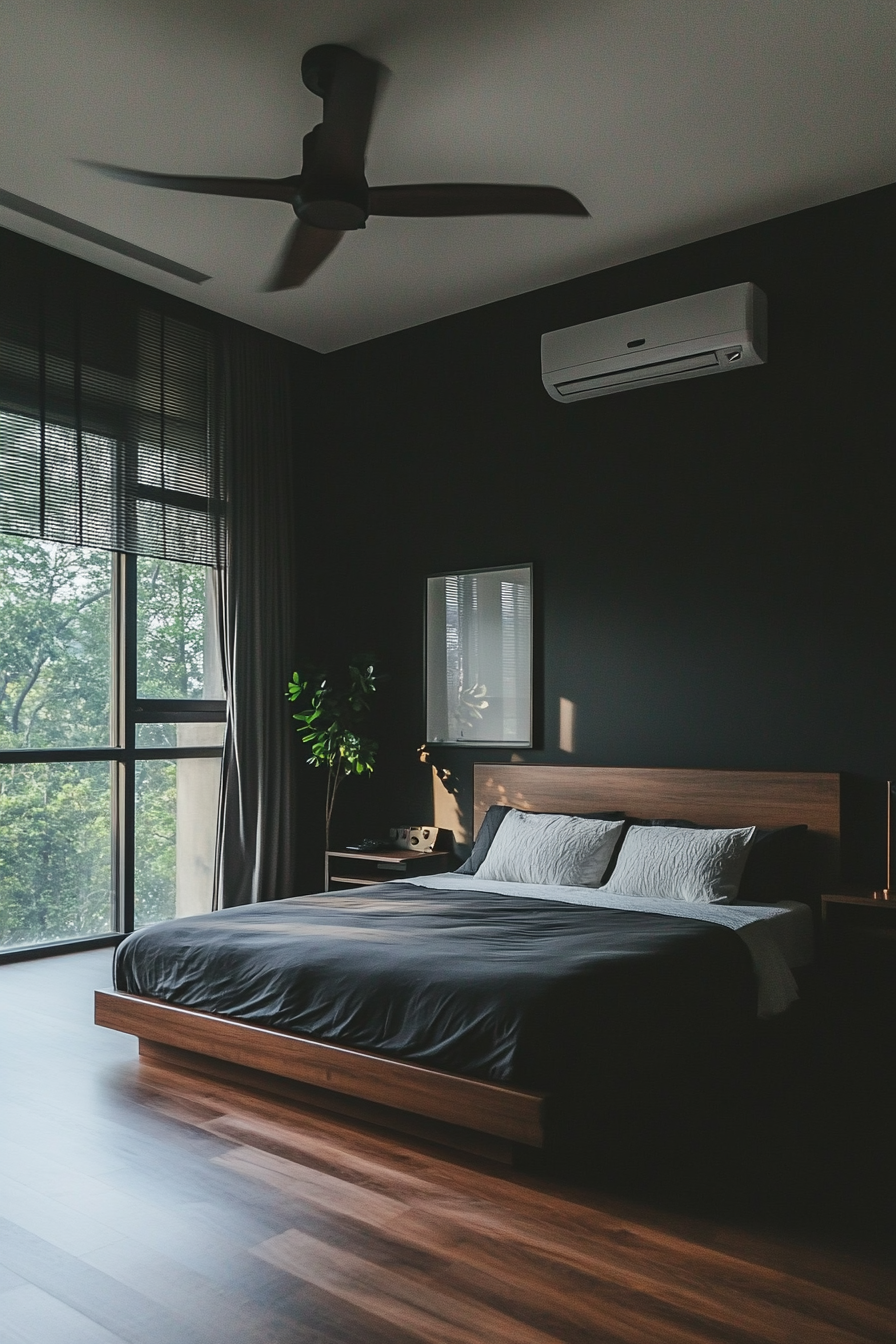
Choose furniture with clean lines and a sleek design to keep the look modern. Black or dark wood furniture can enhance the dramatic effect. Use minimal decor, focusing on a few statement pieces that stand out against the dark backdrop.
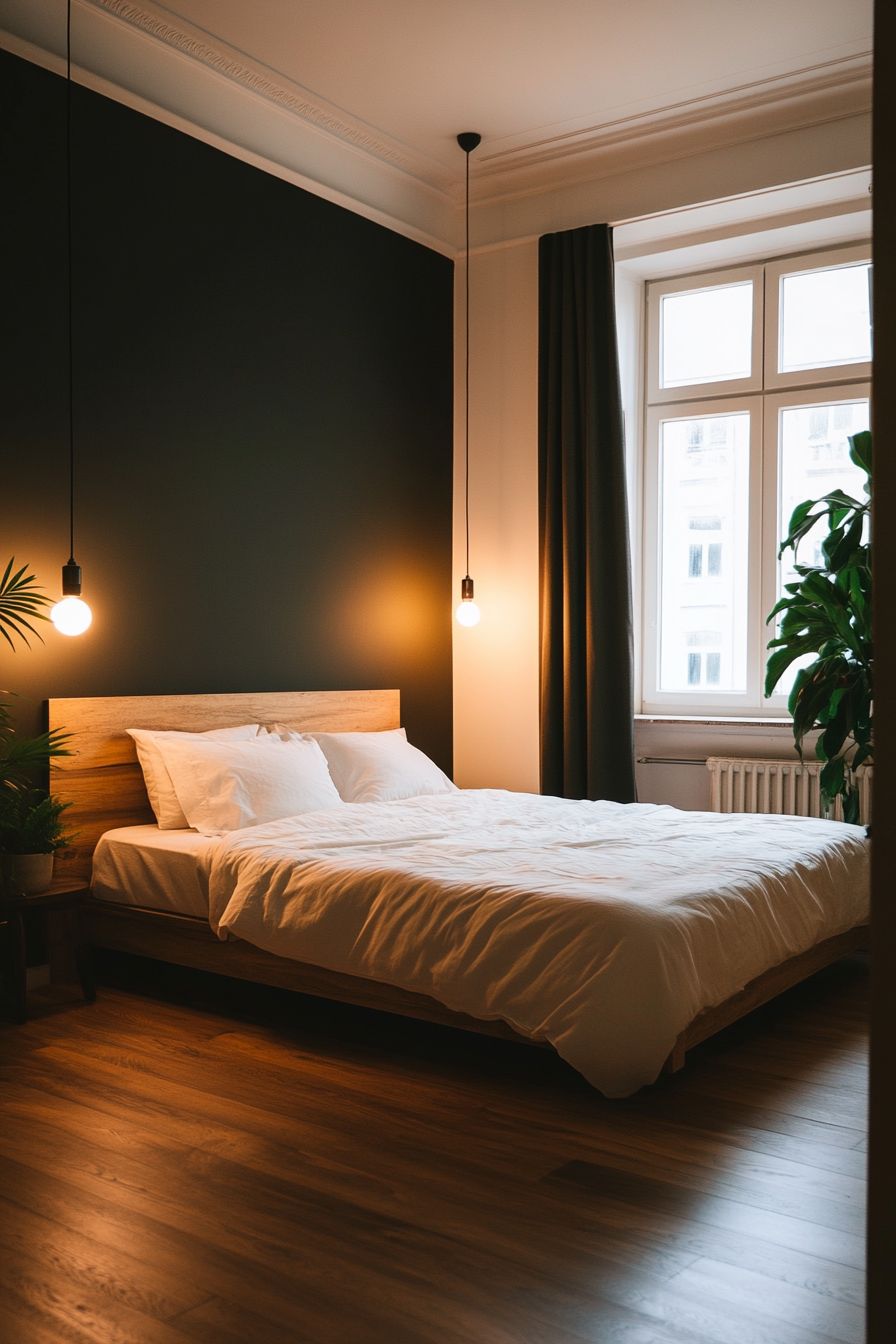
Lighting is key in a dark minimalist bedroom. Use a combination of ambient, task, and accent lighting to create a warm and inviting atmosphere. Soft, warm bulbs can prevent the space from feeling too stark or cold. The result is a bedroom that feels both sophisticated and cozy.
9. Black and White
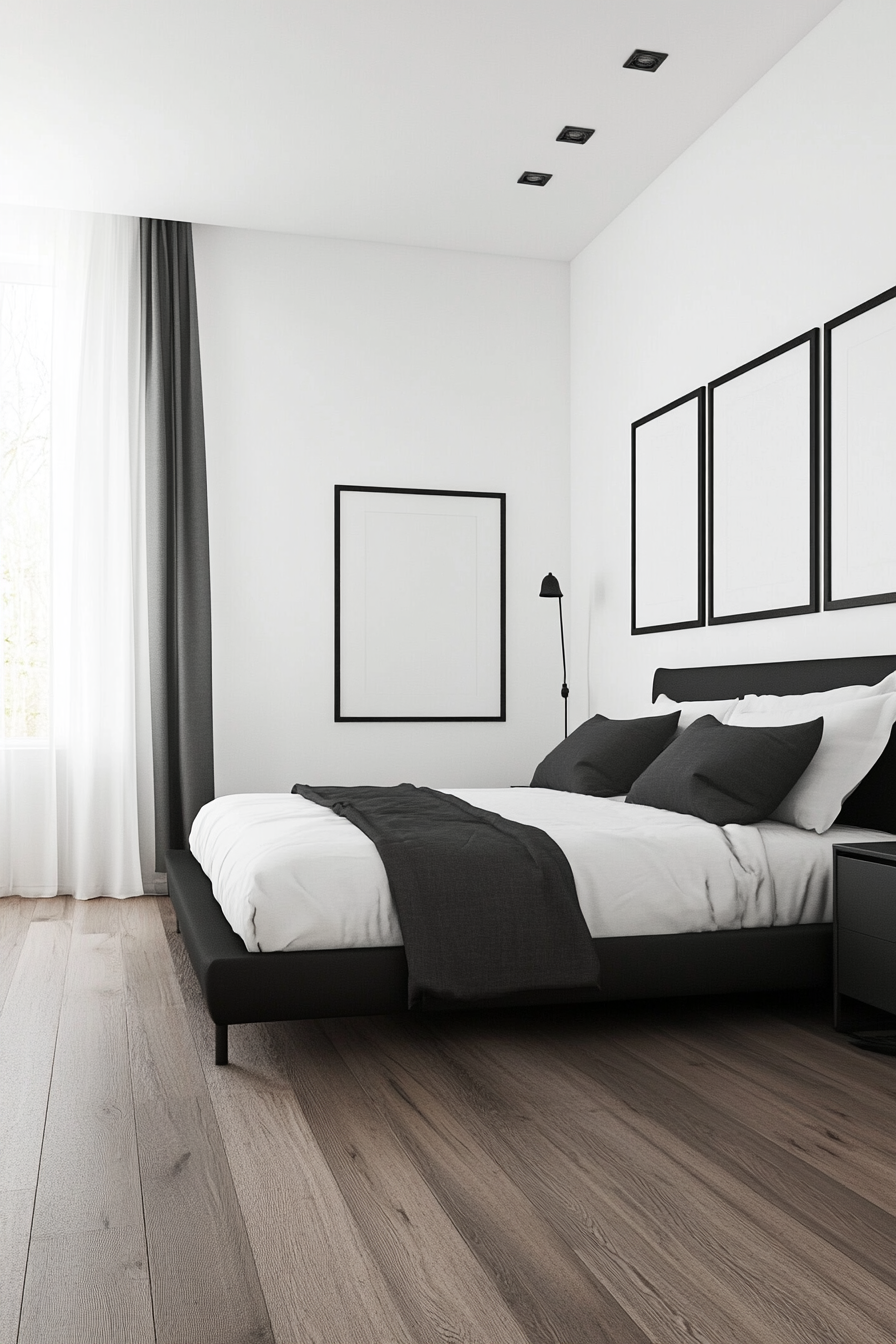
A black and white minimalist bedroom is timeless and sophisticated. Start with a base of white walls and add black accents through furniture, bedding, or decor. This high-contrast look can make the space feel crisp and clean.
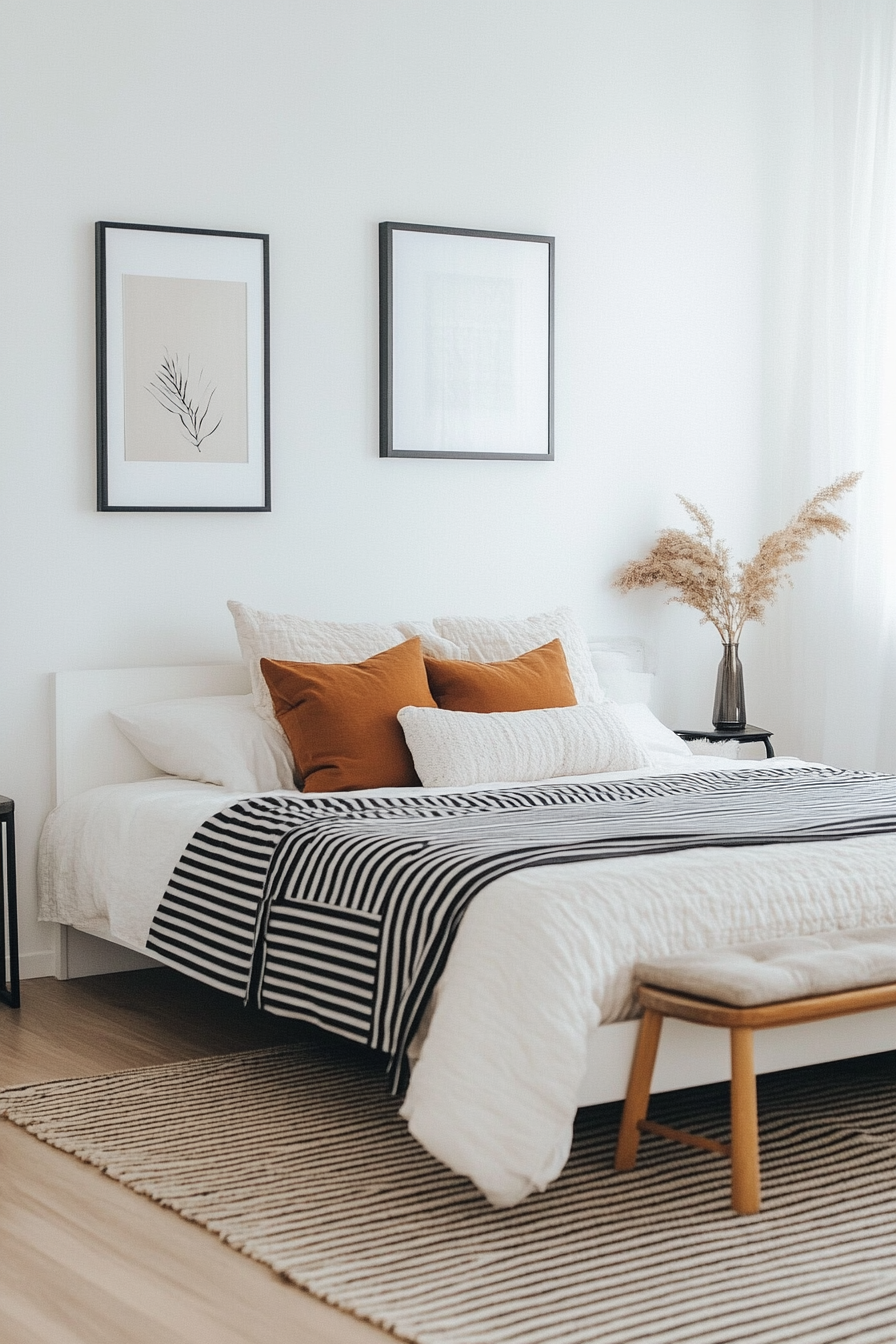
Use patterns sparingly to add interest. Stripes, polka dots, or geometric designs in black and white can create visual interest without adding clutter. Stick to a few key pieces to maintain the minimalist vibe.
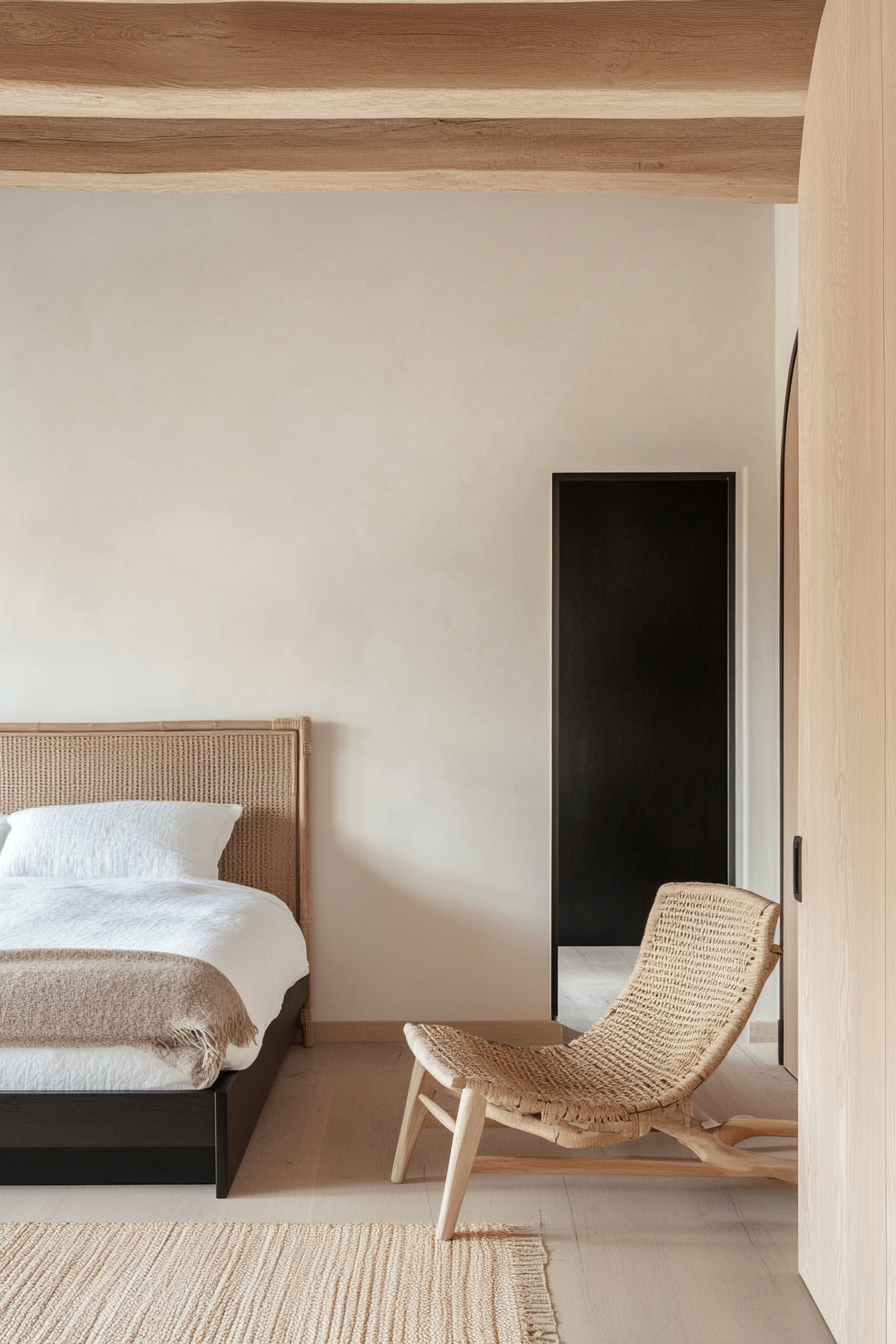
Add warmth through natural materials like wood or rattan. A wooden bed frame, a rattan chair, or a wool rug can soften the stark contrast and add a touch of coziness. The result is a bedroom that feels both modern and inviting.
10. Cozy Minimalism
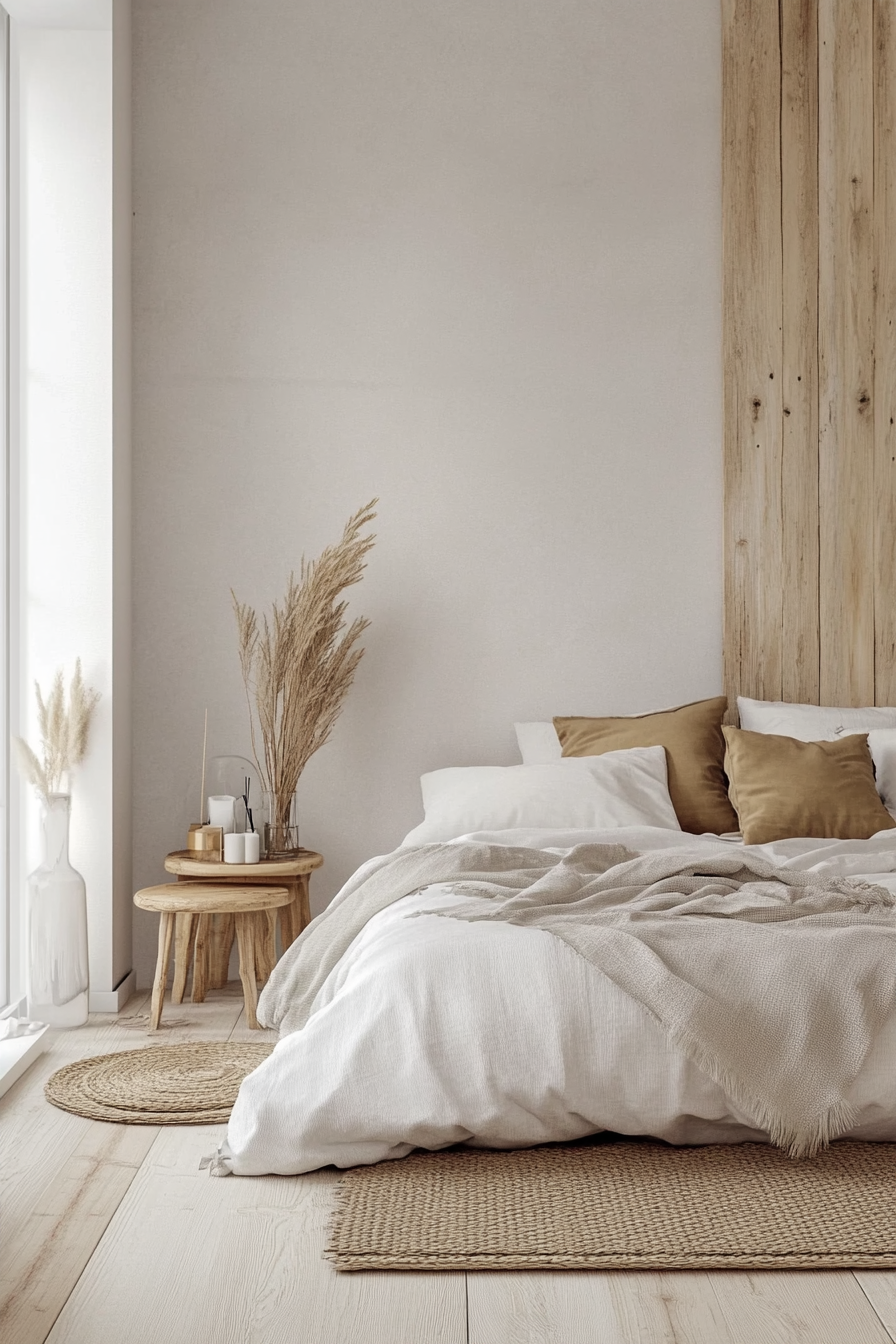
Creating a cozy minimalist bedroom involves balancing simplicity with warmth. Start with a neutral color palette of whites, greys, and soft pastels. Choose furniture with clean lines and add layers of texture through bedding, rugs, and cushions.
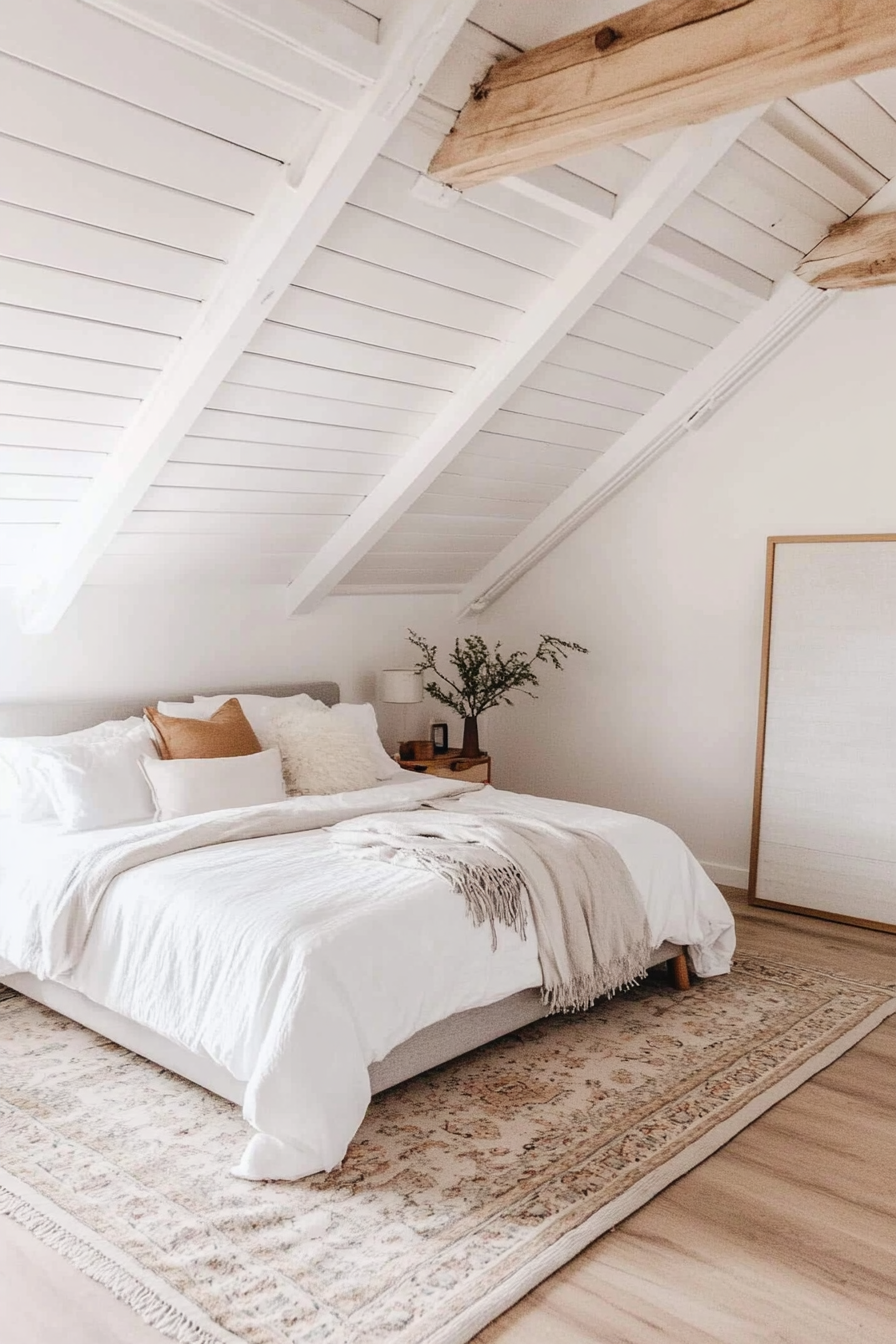
Opt for soft and comfortable materials like cotton, wool, and linen. A plush rug, a cozy throw blanket, or a pile of pillows can make the space feel inviting and warm. Use warm lighting to enhance the cozy atmosphere.
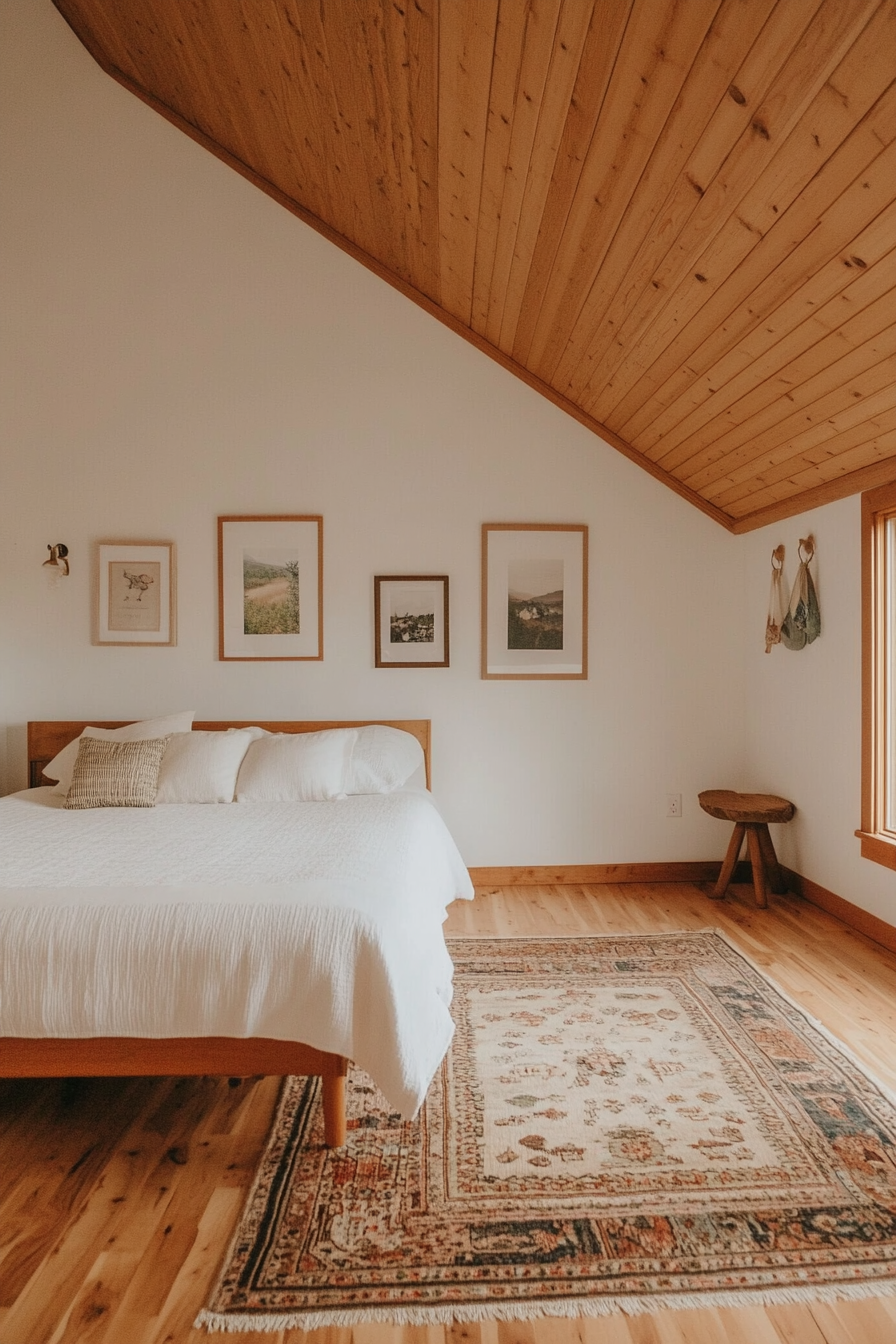
Decorate with a few personal touches like family photos, a favorite book, or a cherished piece of art. The key is to keep it minimal and meaningful. The result is a bedroom that feels both serene and welcoming.
11. Grey Minimalism
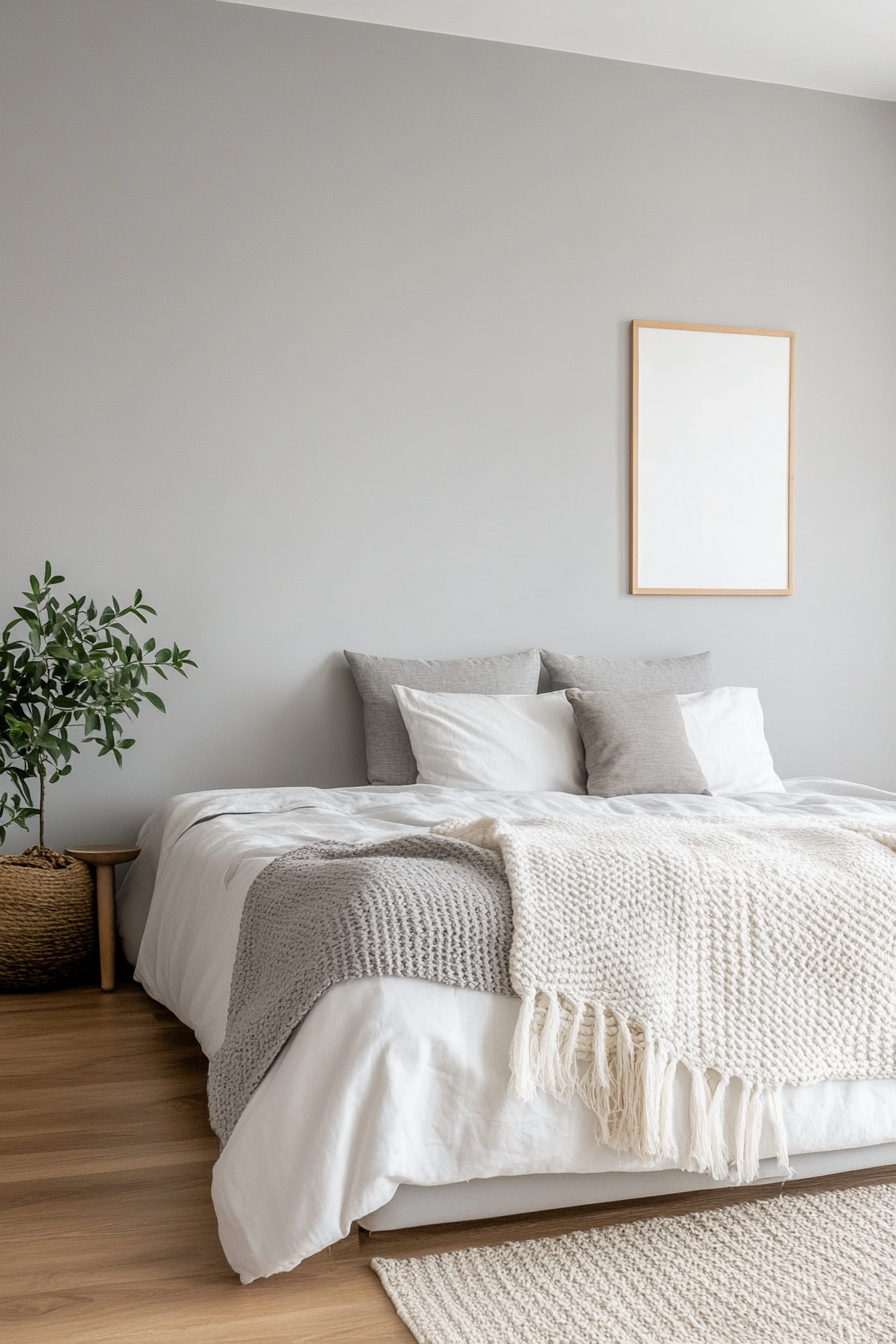
Grey is a versatile color that can create a calm and sophisticated minimalist bedroom. Start with a base of light grey walls and add darker grey accents through furniture, bedding, or decor. This monochromatic palette can make the space feel cohesive and serene.
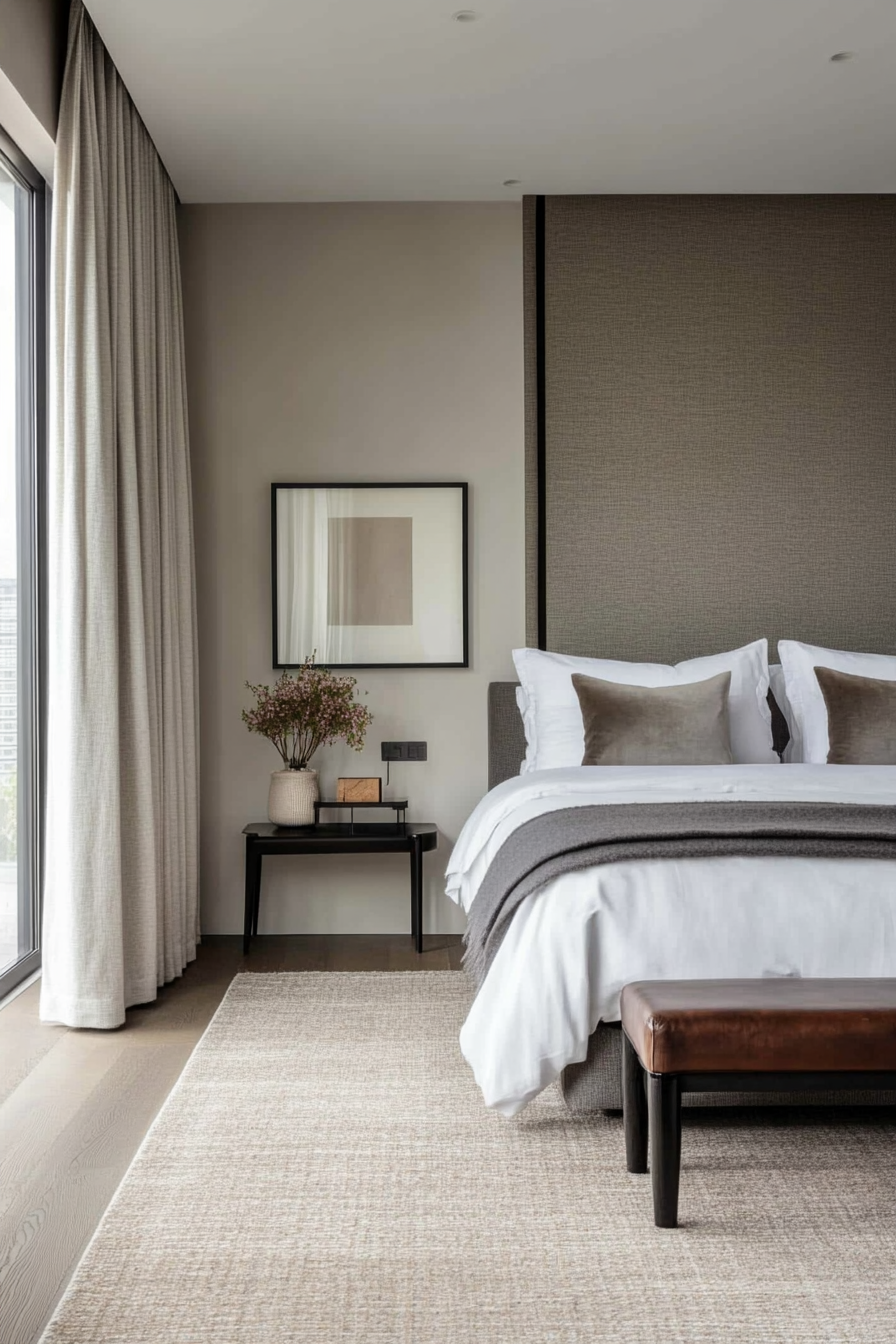
Incorporate different shades and textures of grey to add depth and interest. A grey velvet headboard, a wool rug, or linen bedding can create a rich and inviting look. Use metallic accents like silver or chrome to add a touch of glamour.
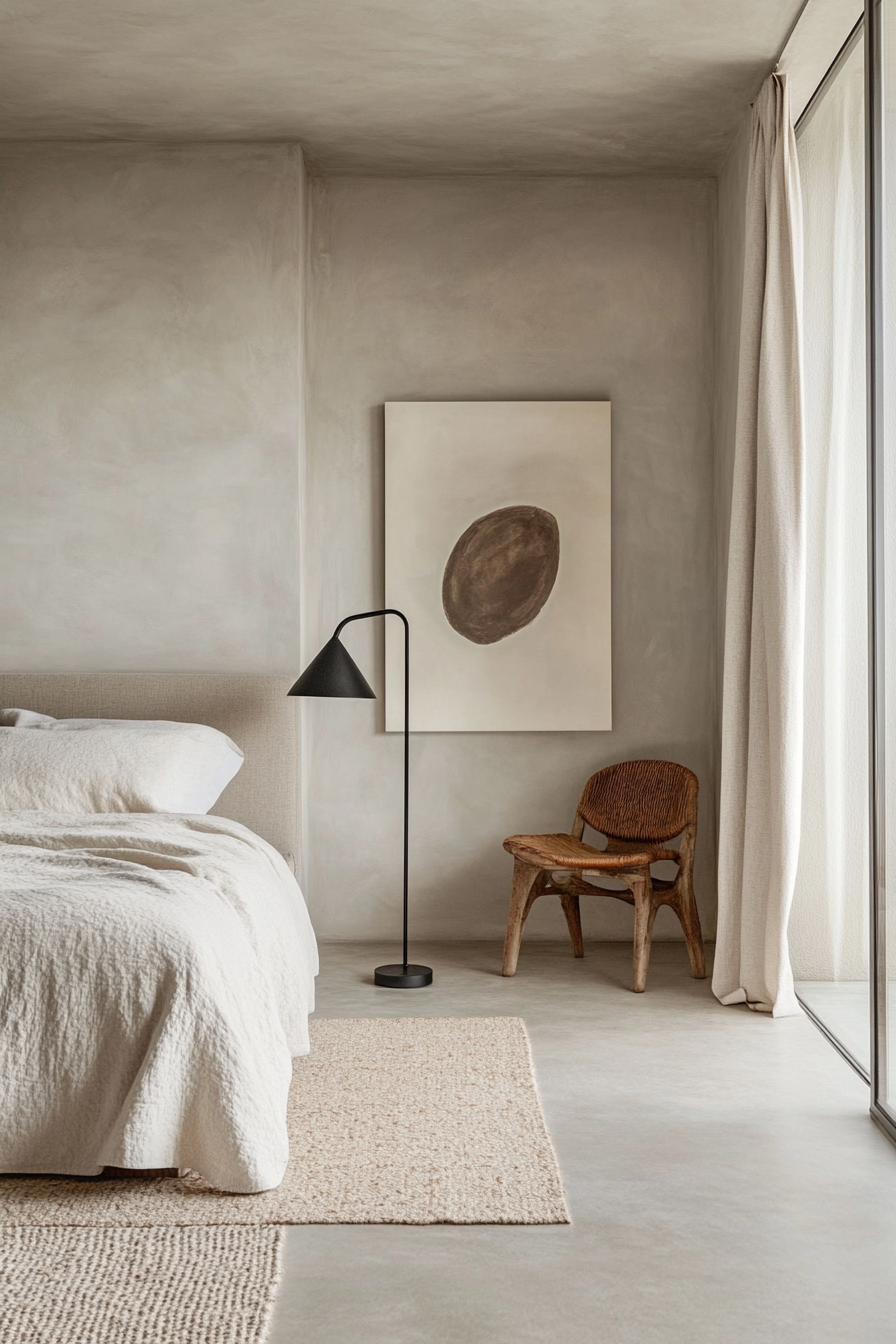
Keep decor simple and streamlined. A few well-chosen pieces like a piece of abstract art or a sculptural lamp can add personality without overwhelming the space. The result is a bedroom that feels elegant and peaceful.
12. Bohemian Minimalism
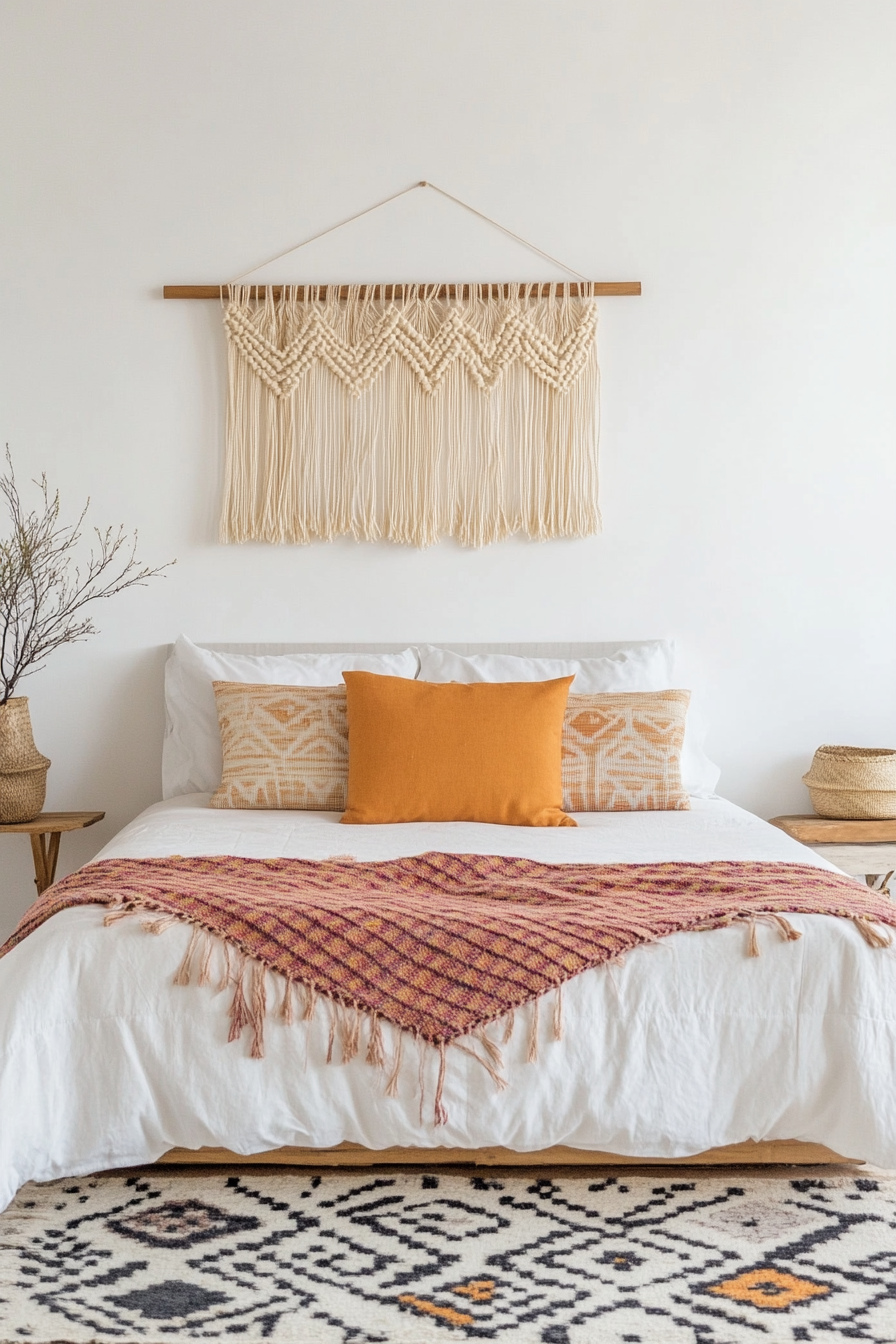
Bohemian minimalism combines the eclectic style of boho with the simplicity of minimalism. Start with a neutral base and add bohemian touches through textiles, patterns, and natural materials. A white or beige backdrop allows colorful boho elements to stand out.
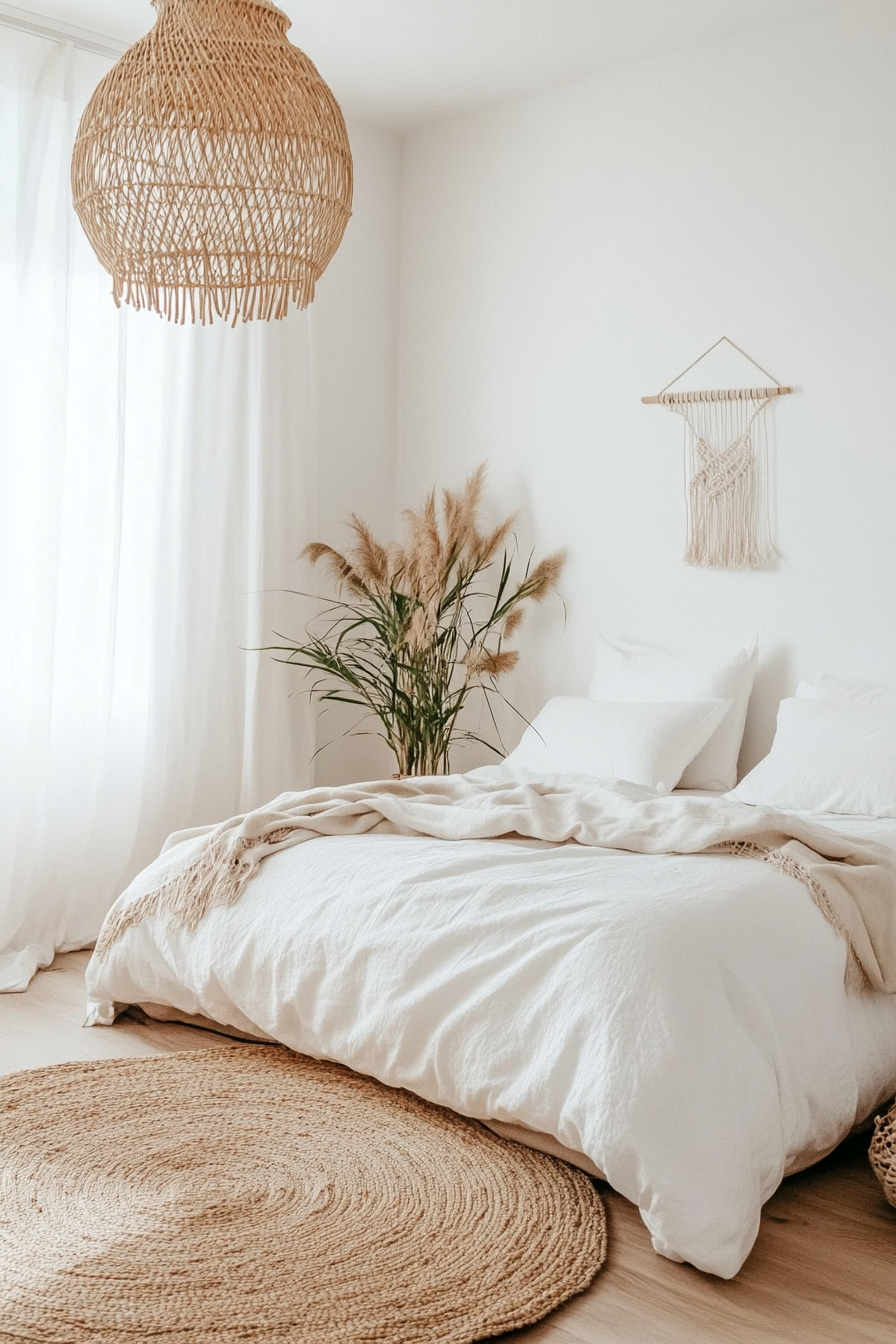
Incorporate bohemian elements like a woven wall hanging, a macramé plant holder, or a patterned rug. Choose pieces with natural textures like rattan, jute, and wood to add warmth and interest. The key is to balance the boho elements with minimalist principles to avoid a cluttered look.
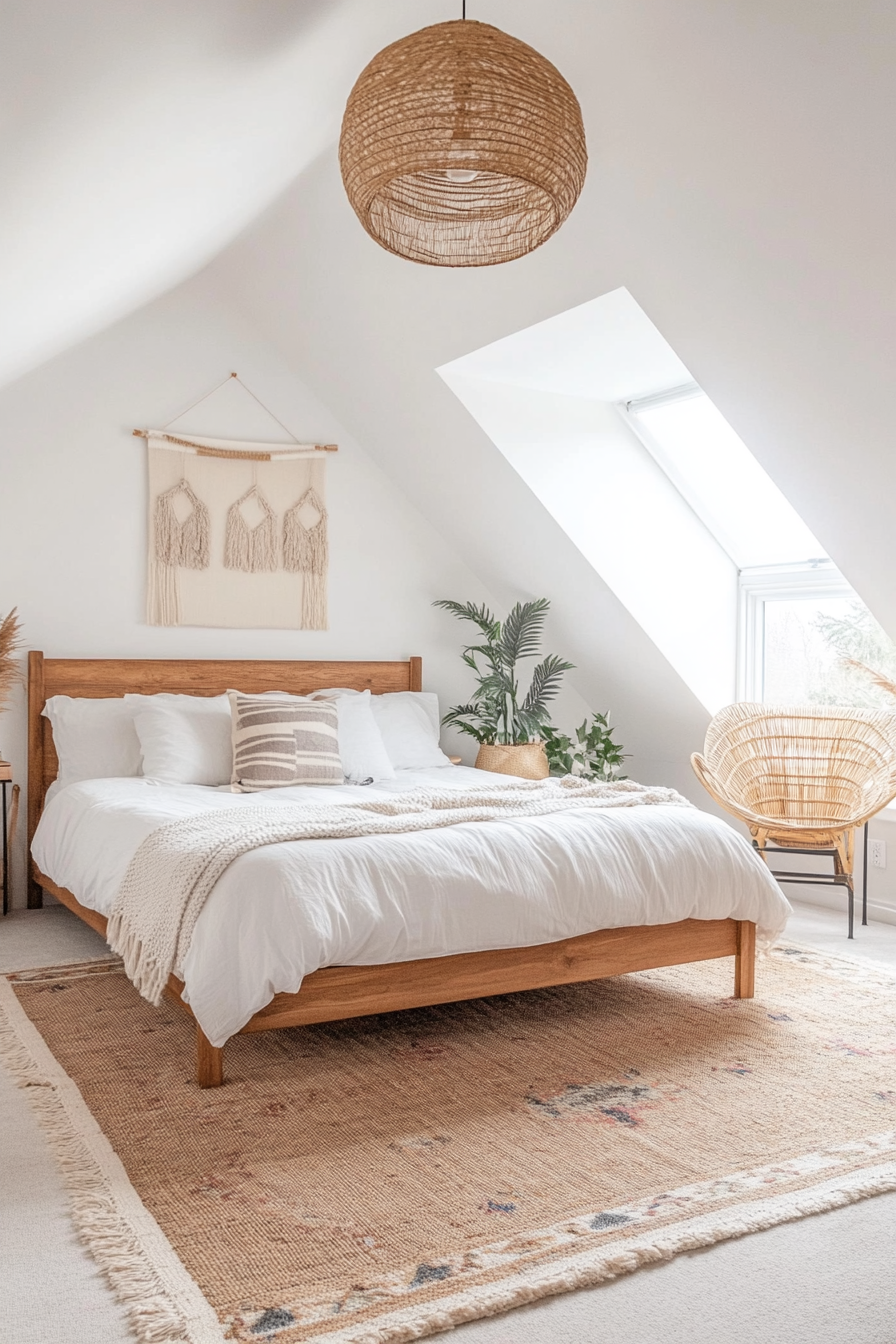
Use a mix of modern and vintage furniture to create a curated and collected feel. A vintage wooden bed frame or a modern rattan chair can add character and personality. The result is a bedroom that feels both relaxed and refined.
13. Natural Textures
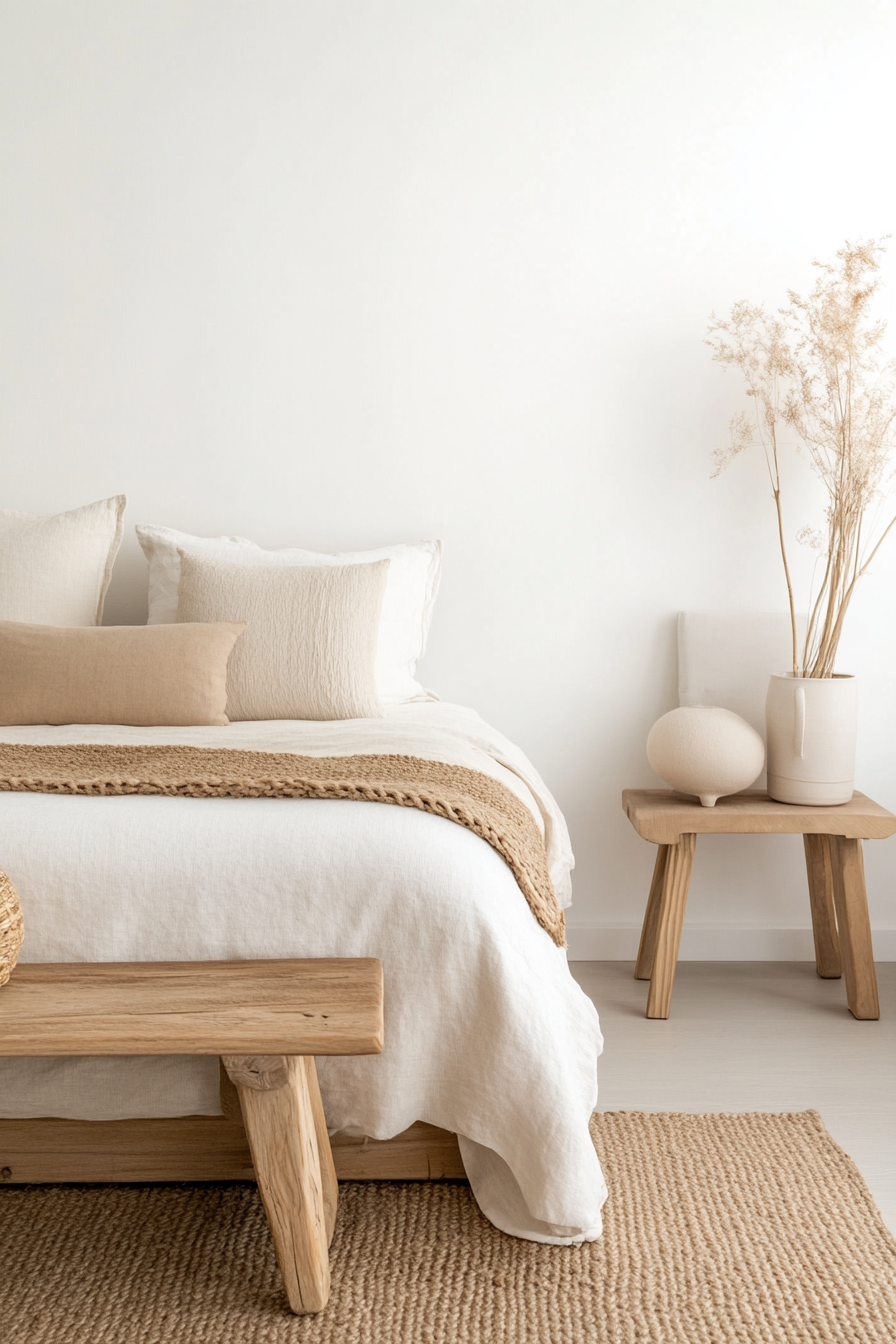
Incorporating natural textures into a minimalist bedroom can add warmth and depth. Start with a neutral color palette and layer in materials like wood, linen, wool, and stone. These elements can create a cozy and inviting atmosphere while maintaining a minimalist aesthetic.
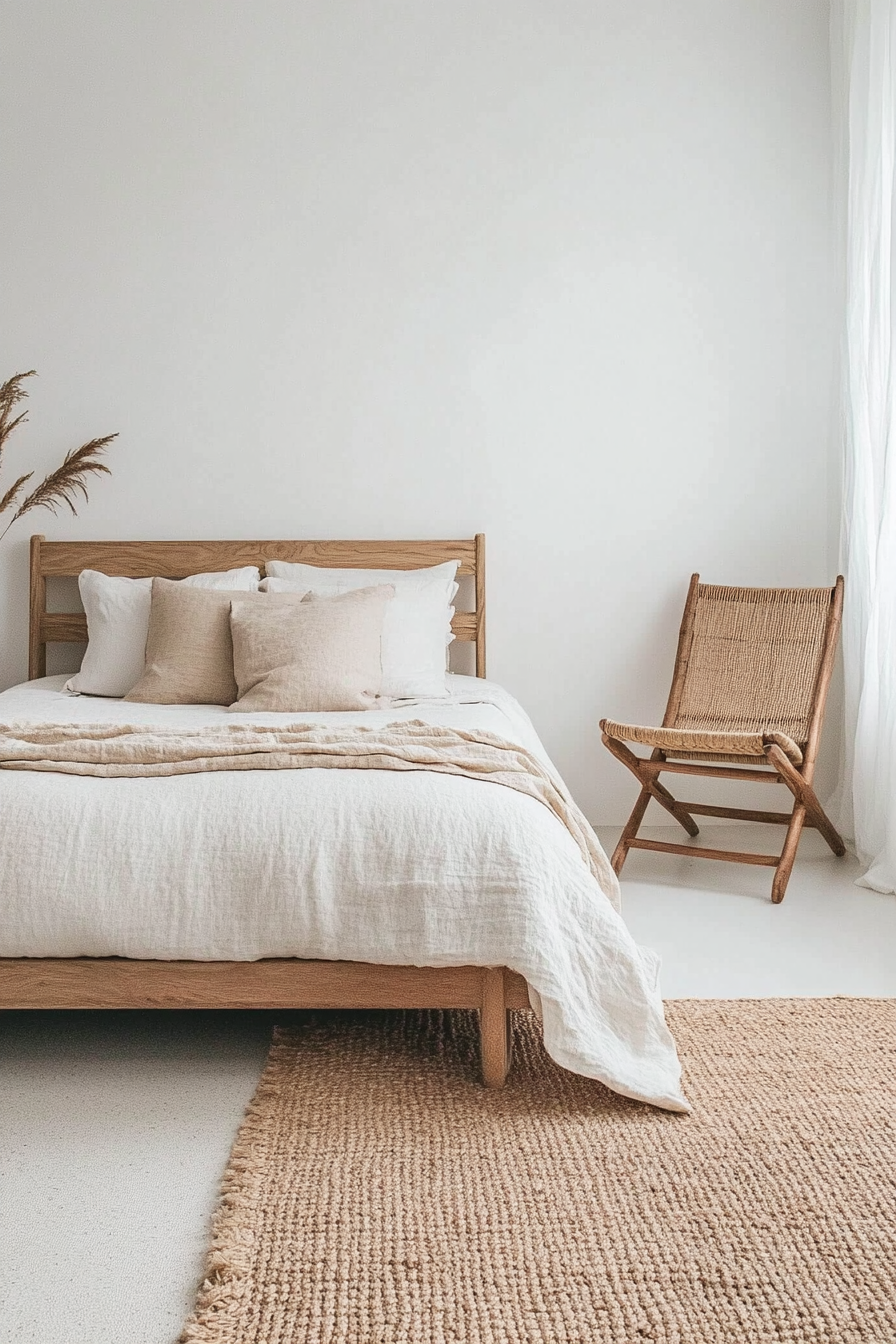
Choose furniture made from natural materials like a wooden bed frame or a rattan chair. Add texture through bedding and rugs—think linen sheets, a wool throw, or a jute rug. These materials can make the space feel rich and layered.
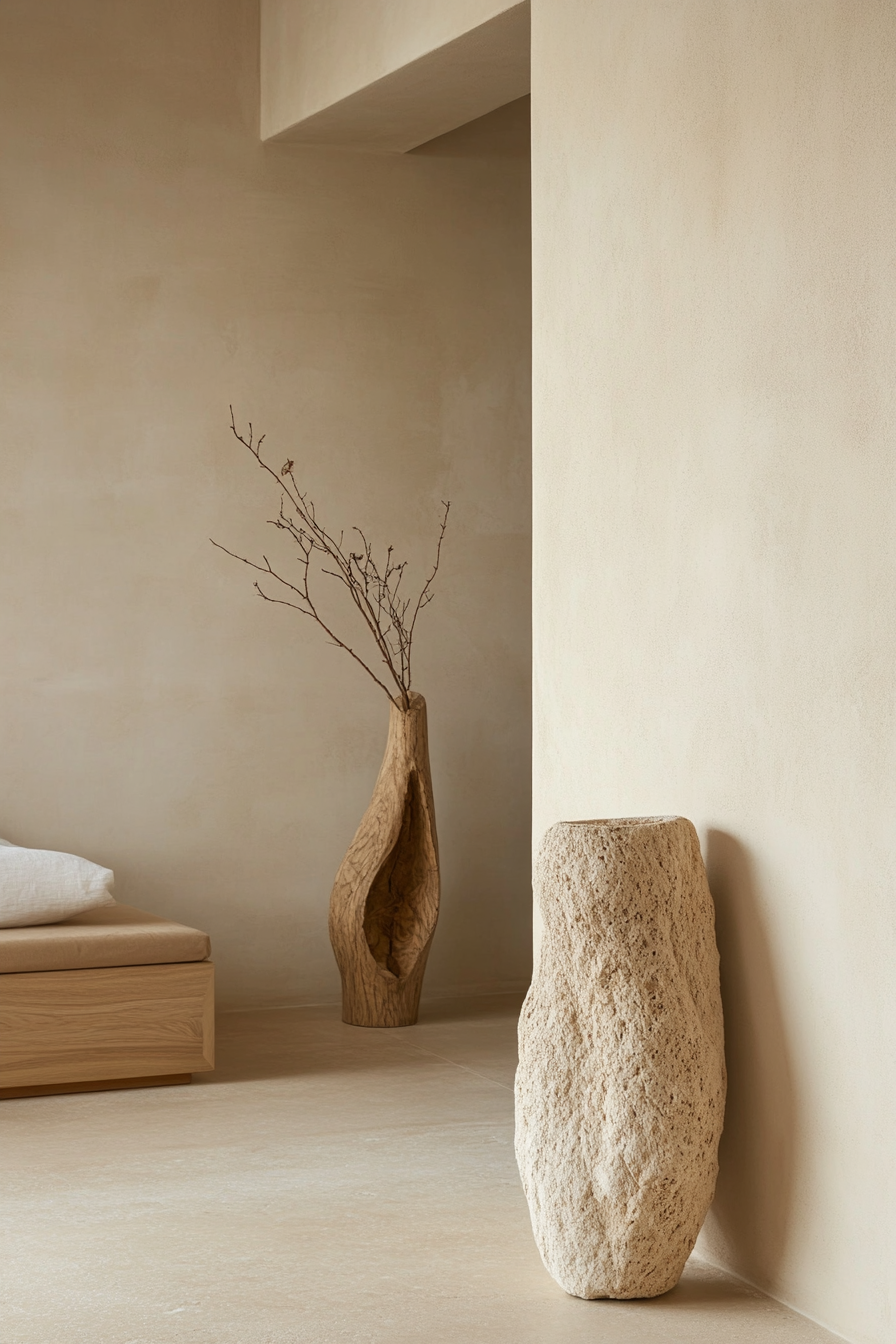
Keep decor simple and focused on quality. A stone vase, a wooden sculpture, or a linen lampshade can add subtle interest without creating clutter. The result is a bedroom that feels both natural and serene.
14. Minimalism for Men
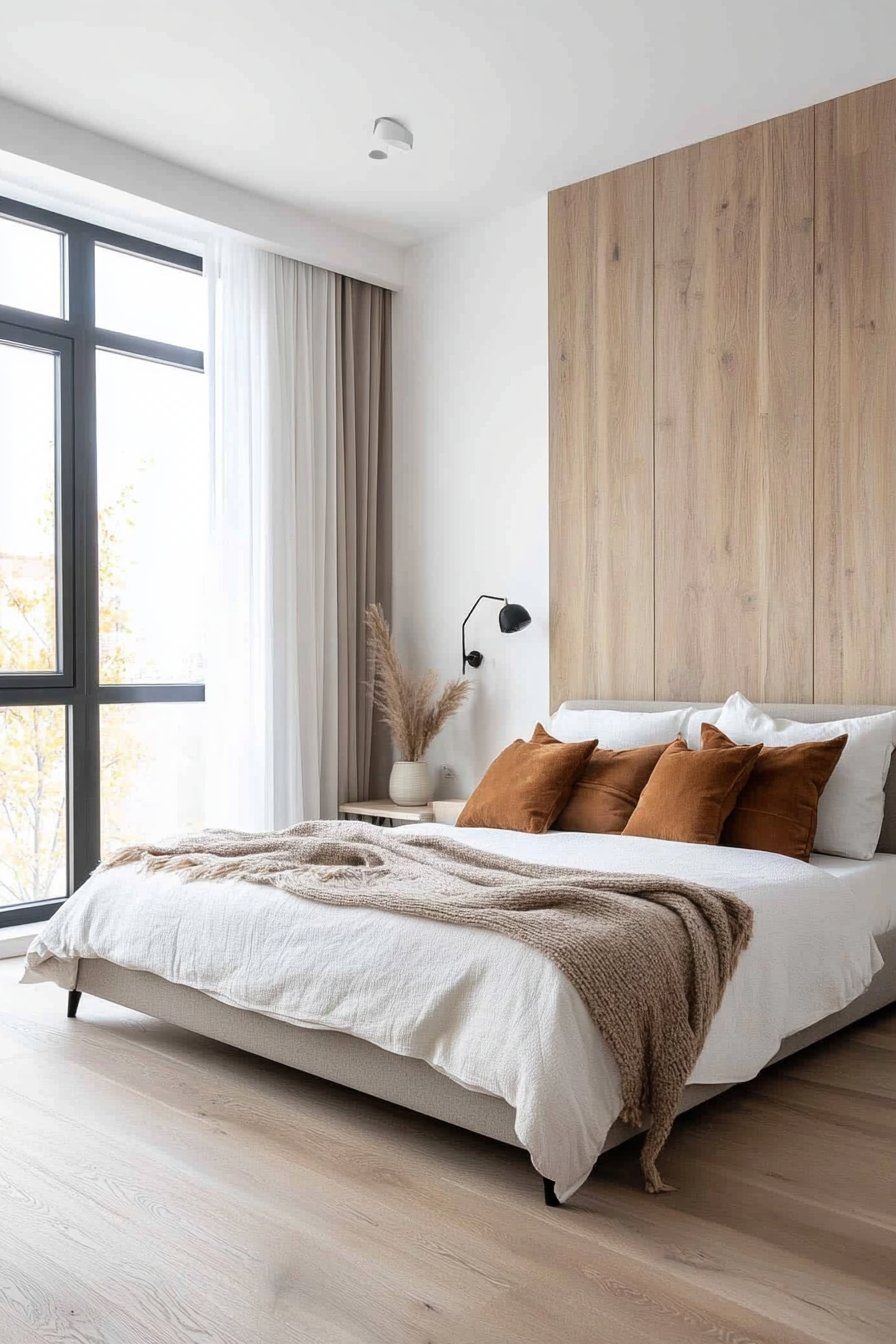
Minimalist bedrooms for men often focus on simplicity, functionality, and a masculine color palette. Start with a base of neutral colors like grey, black, and white. Choose furniture with clean lines and a rugged, industrial feel—think metal bed frames, leather chairs, and reclaimed wood.
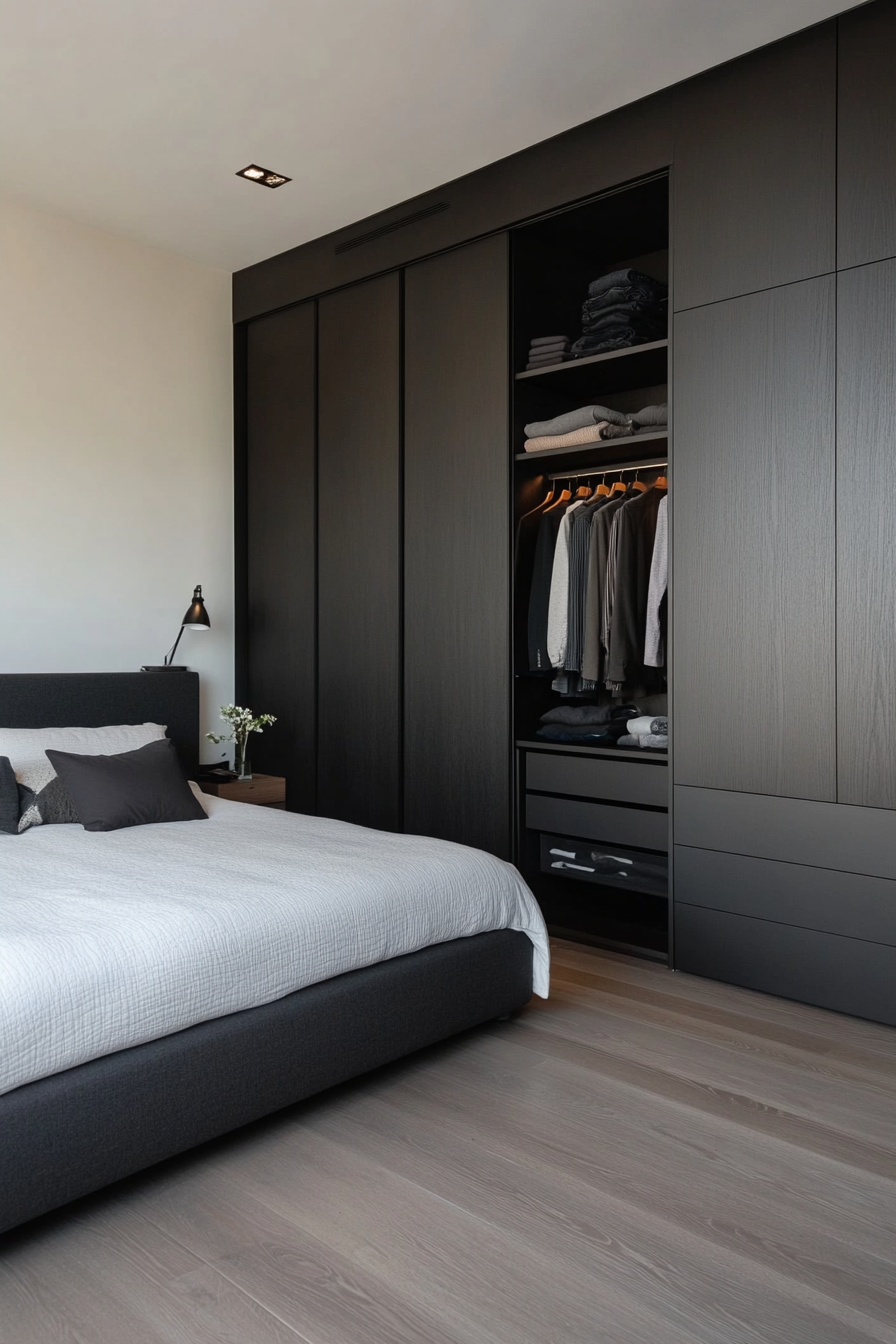
Incorporate storage solutions that keep the space organized and clutter-free. Built-in closets, under-bed storage, and wall-mounted shelves can help maintain a sleek and orderly environment. Keep decor minimal and functional.
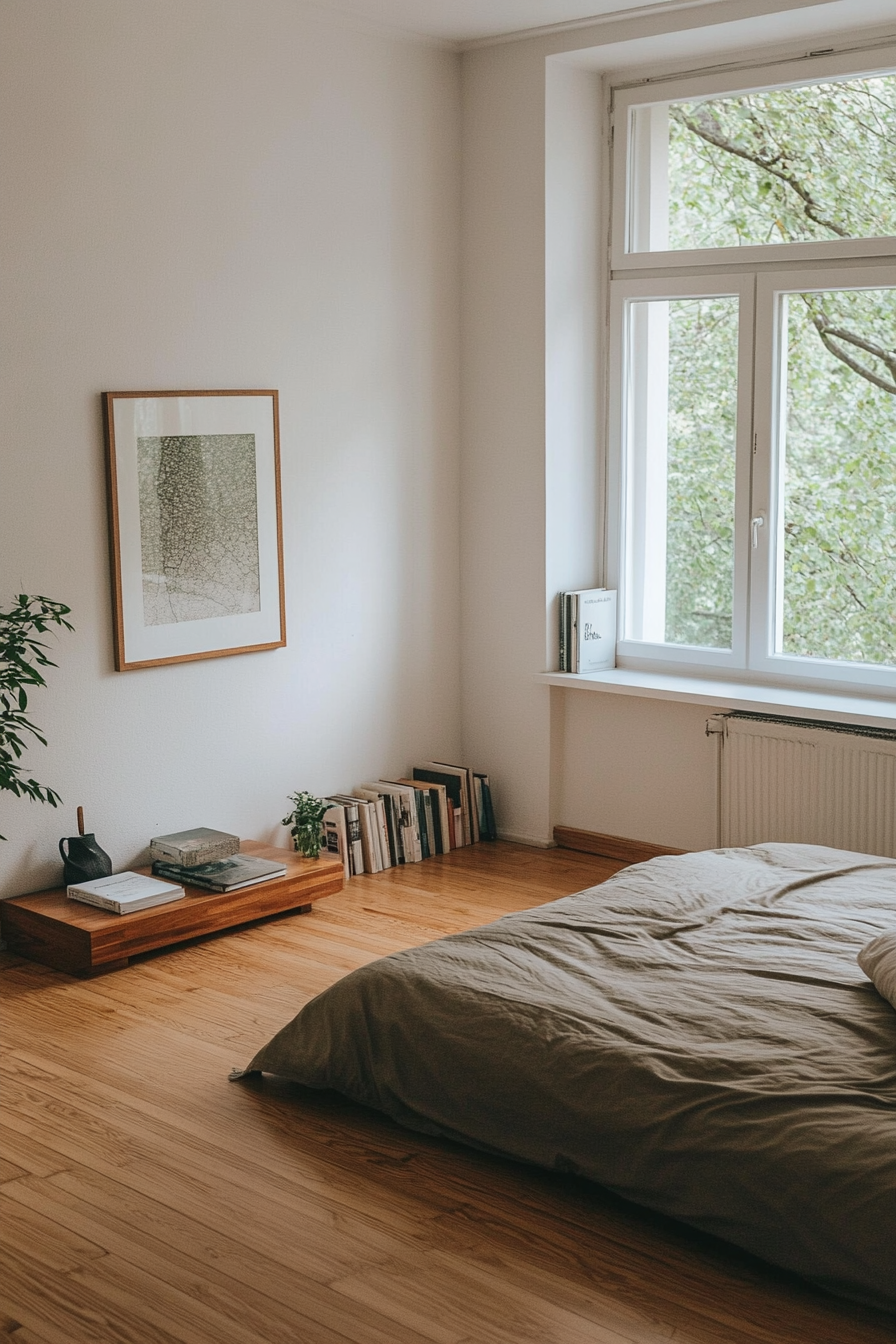
Add personal touches through artwork, books, or a favorite piece of furniture. The key is to keep it simple and meaningful. The result is a bedroom that feels both masculine and serene.
15. Paint Colors for Minimalism
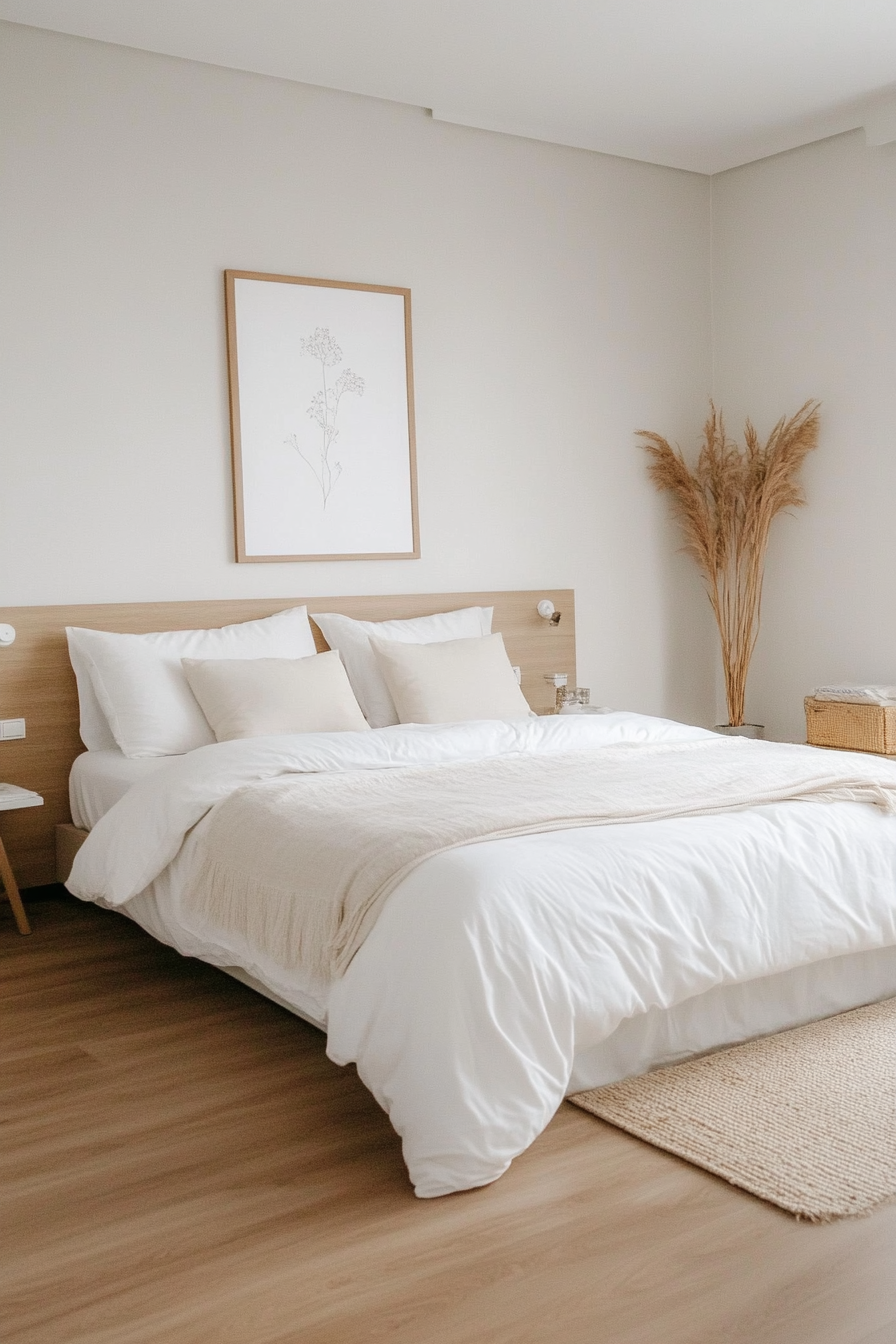
Choosing the right paint colors is essential for creating a minimalist bedroom. Neutral colors like white, beige, and grey are popular choices as they create a calm and serene backdrop. These shades can make the room feel larger and more open.
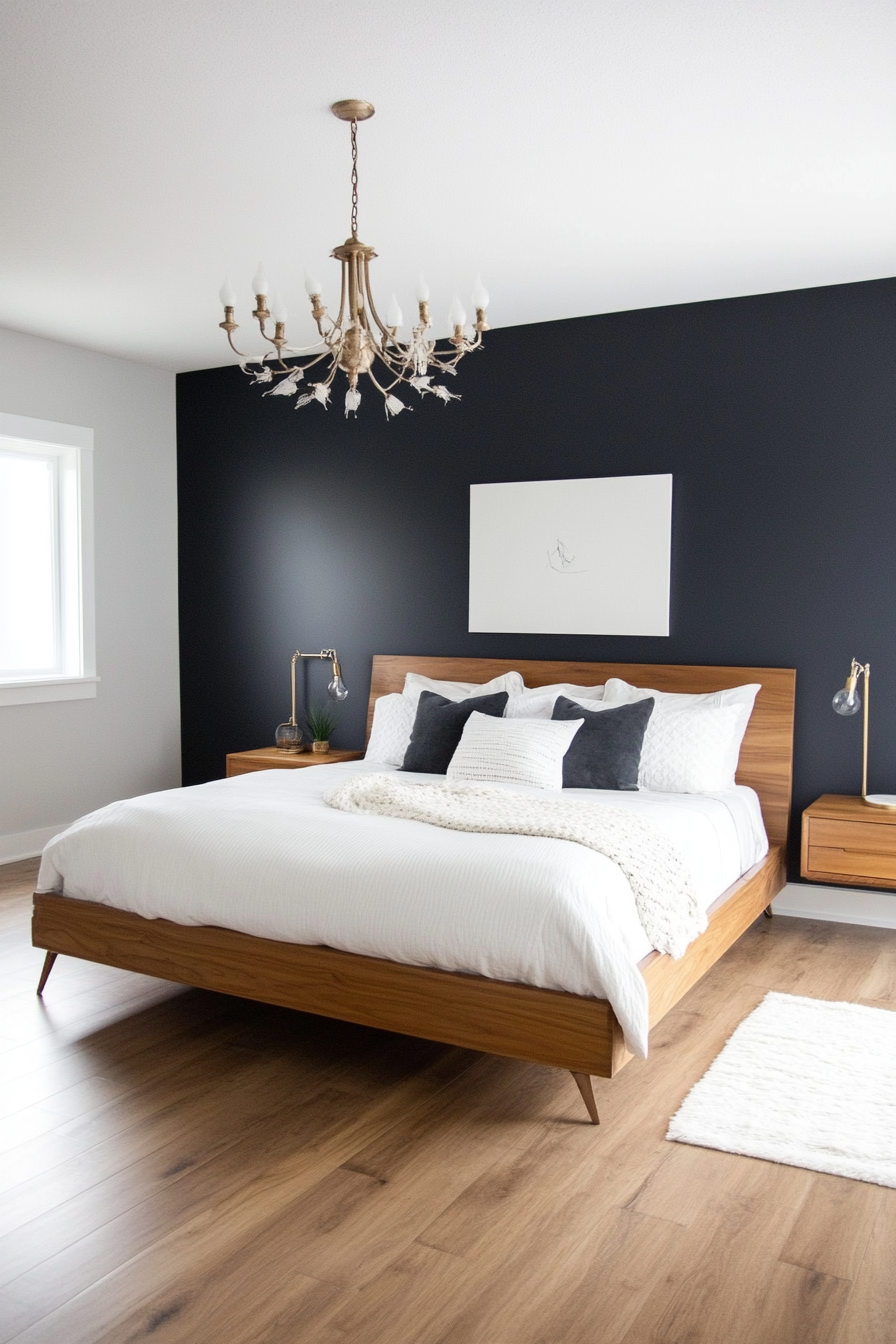
For a bit of contrast, consider using darker shades like charcoal or navy on an accent wall. This can add depth and interest without overwhelming the space. Pastel colors like soft pink, mint green, or pale blue can also work well, adding a subtle touch of color while maintaining the minimalist vibe.
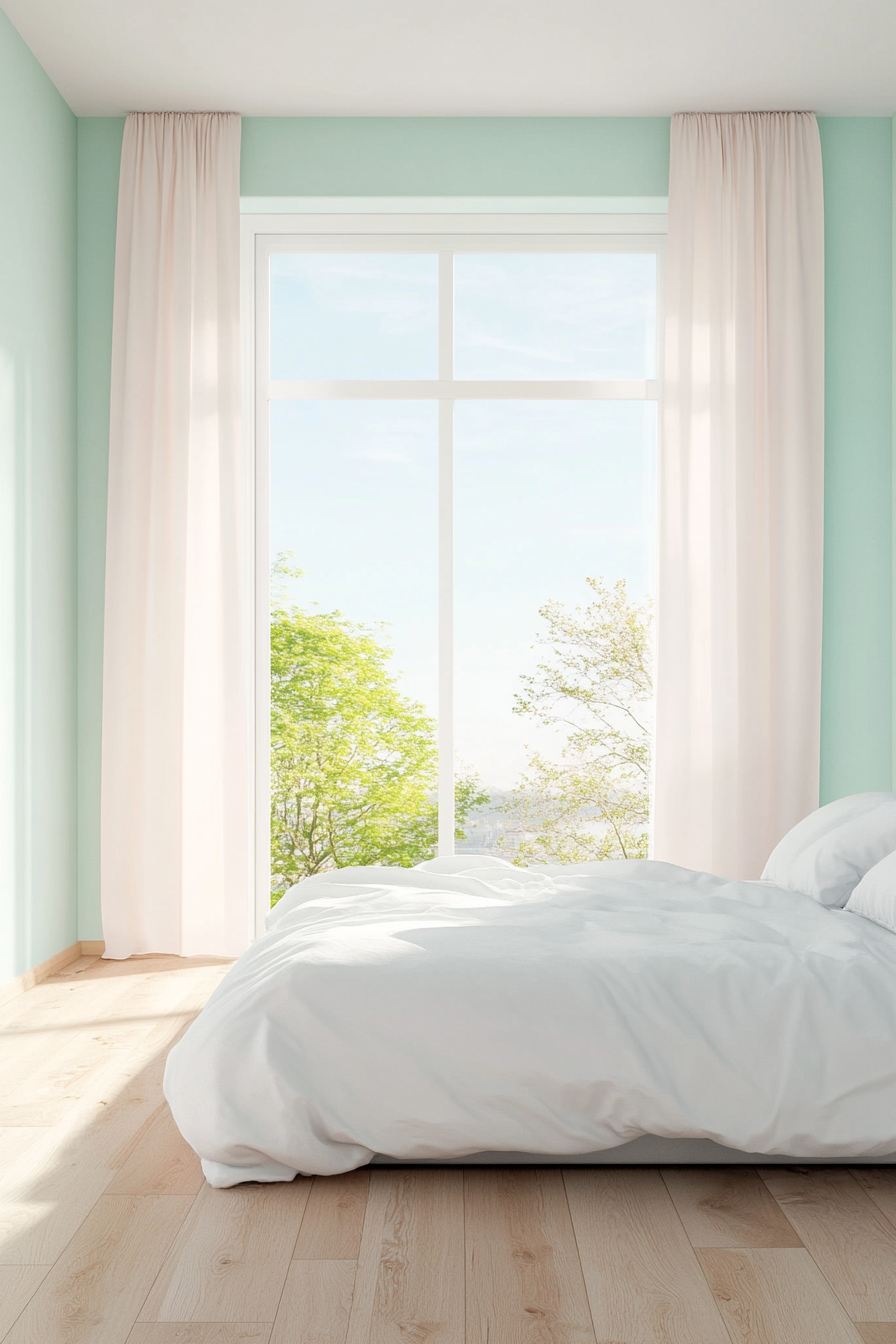
Stick to a monochromatic color scheme to keep the look cohesive and uncluttered. Use different shades and tones of the same color to add depth and interest. The result is a bedroom that feels harmonious and serene.




